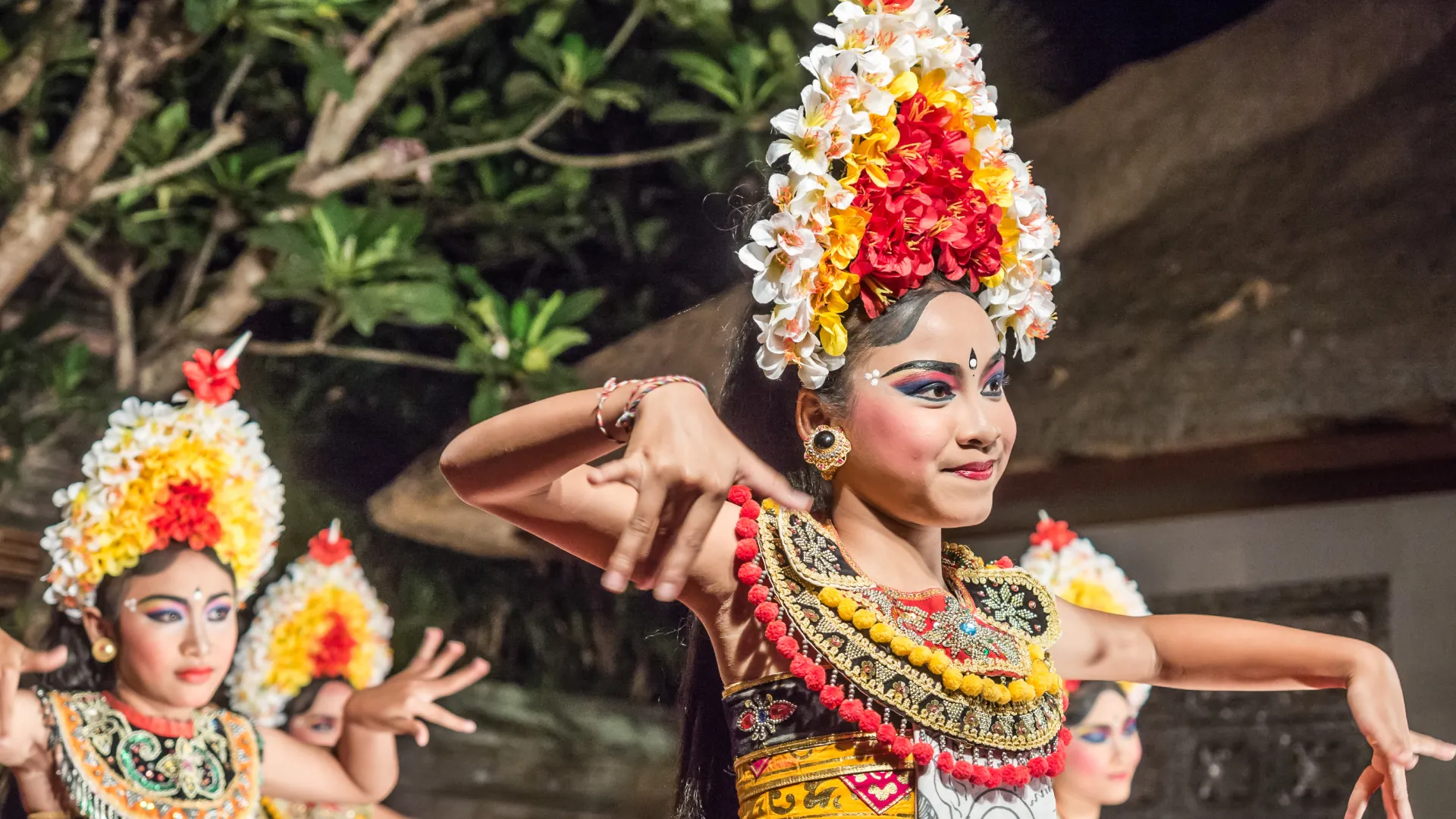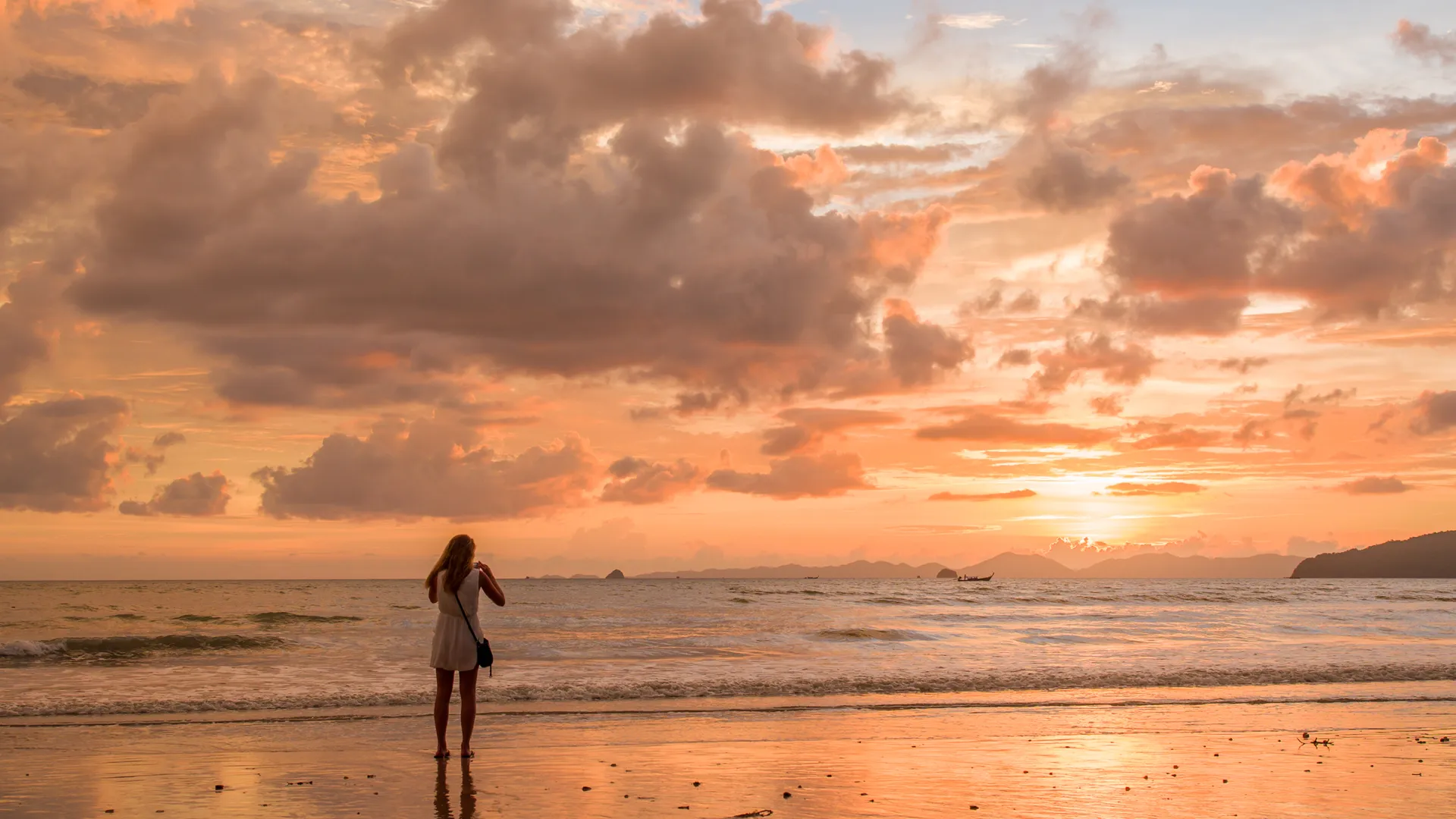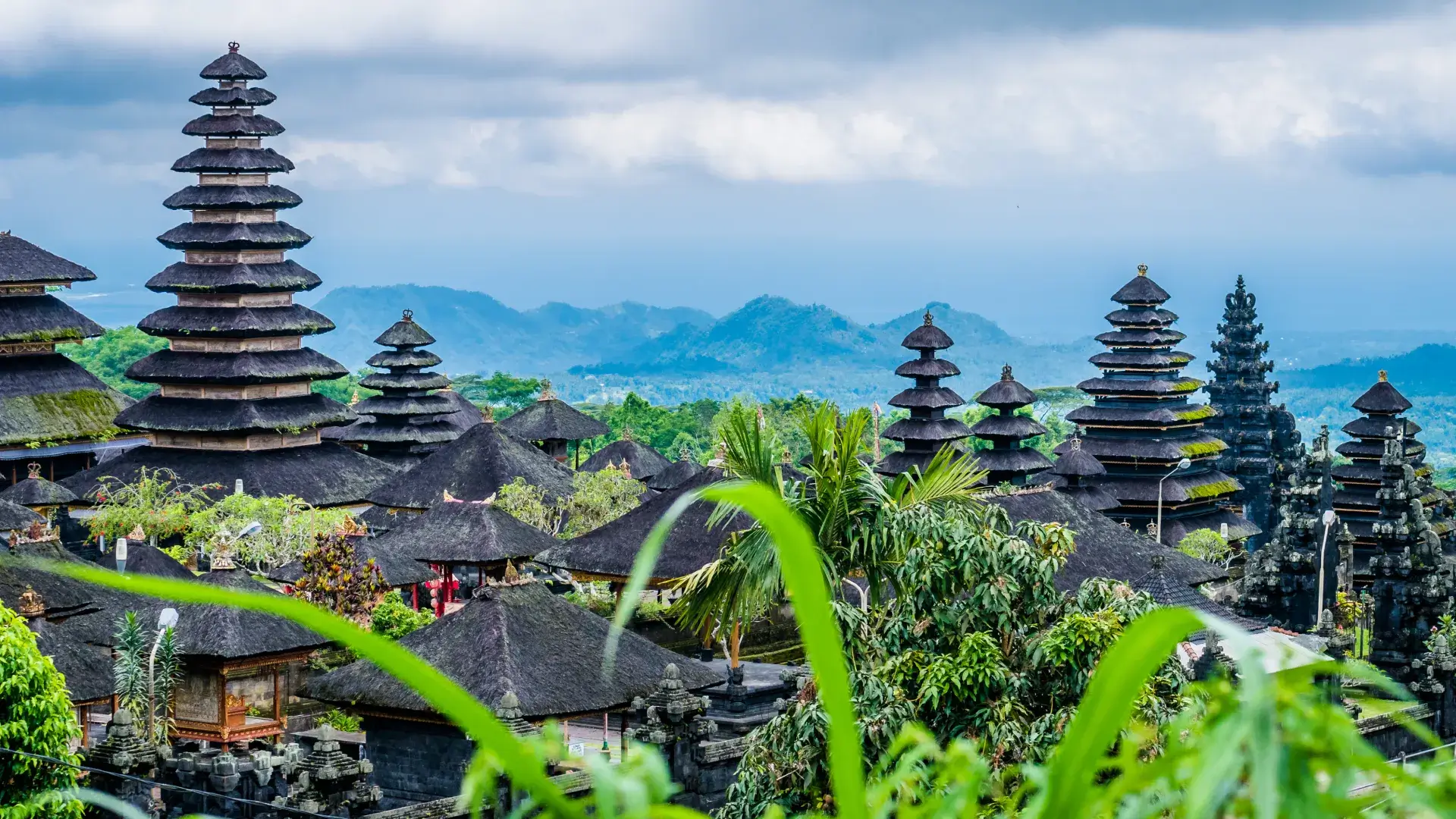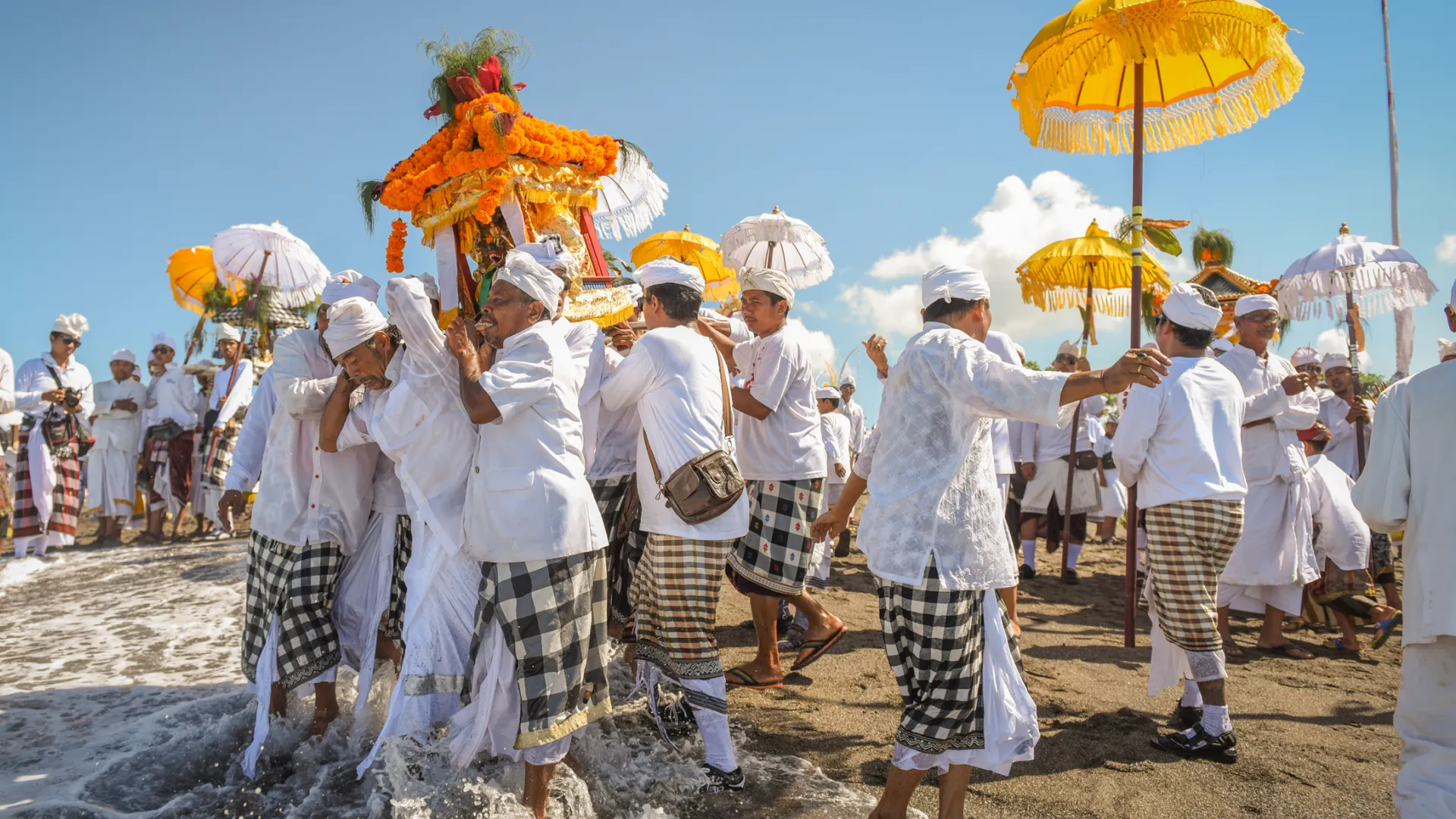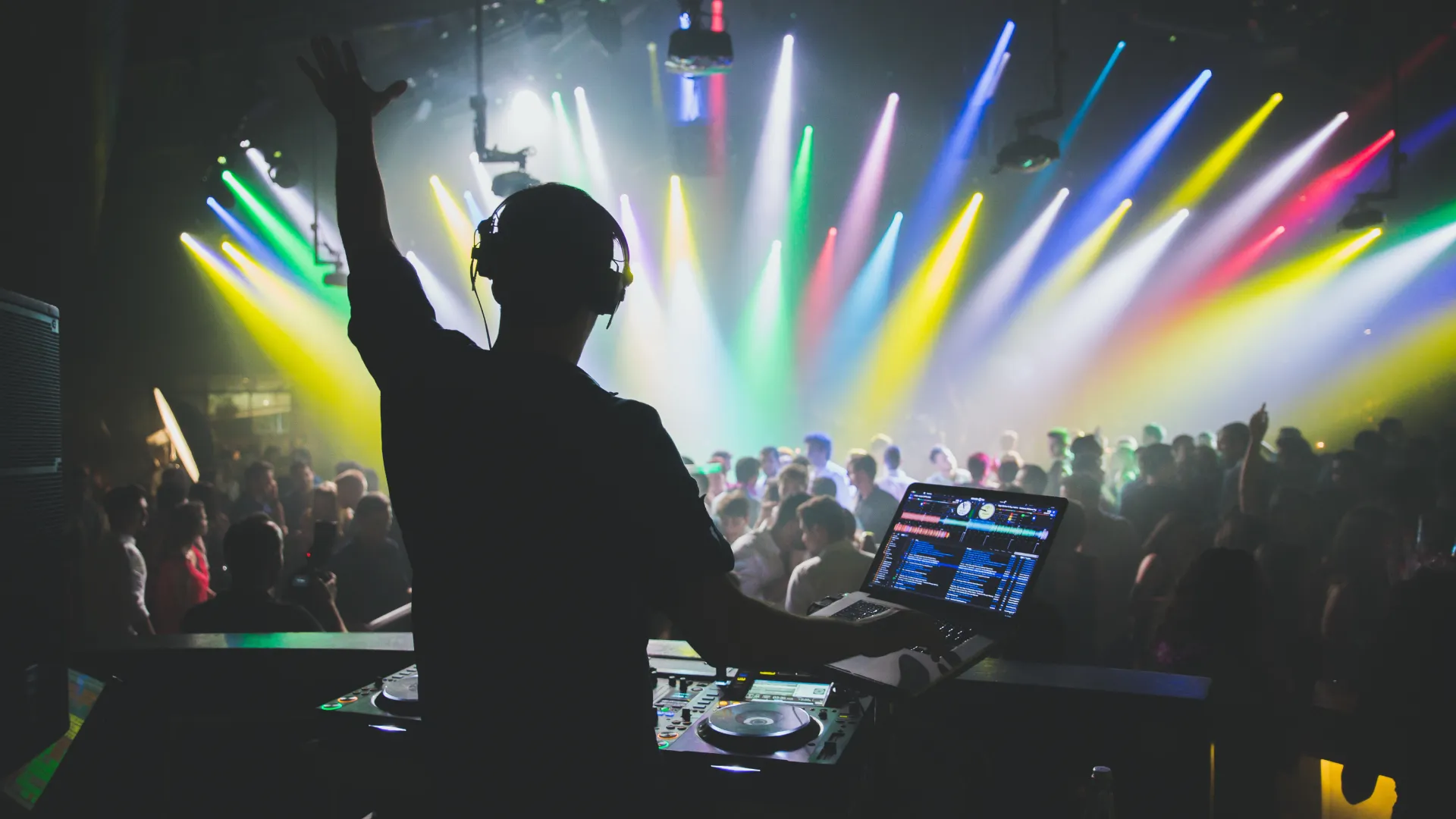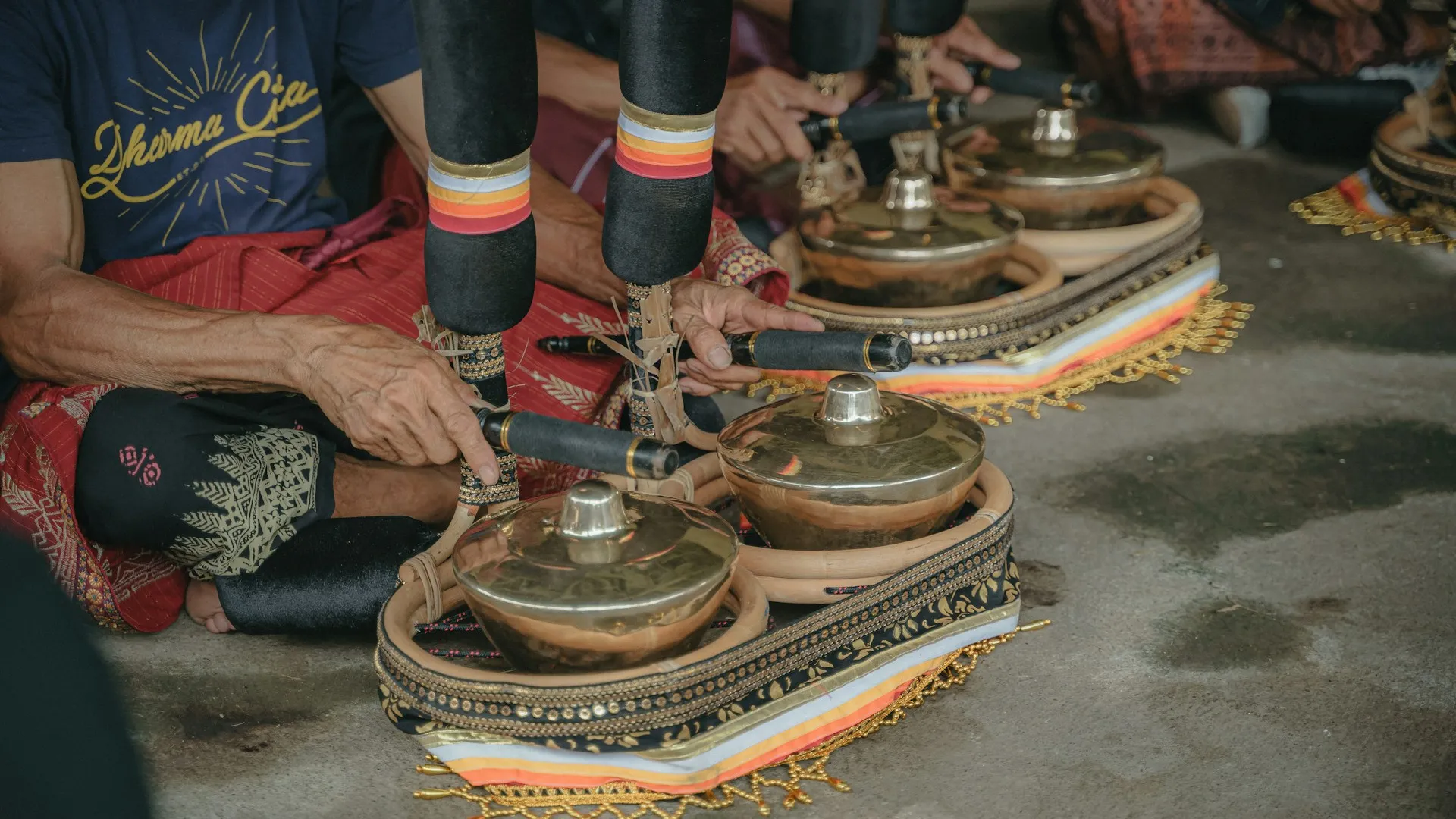Bali is a destination that offers more than beaches and sunsets—its cultural heart beats strongest through its temples, ancient palaces, and traditional villages.
With this carefully curated list of 23 must-visit landmarks, you’ll uncover the island’s spiritual essence and timeless traditions.
From the mystical Pura Besakih to the breathtaking views at Jatiluwih Rice Terraces, each site tells a story that’s deeply entangled with Bali’s history and heritage.
1. Pura Besakih (Mother Temple)
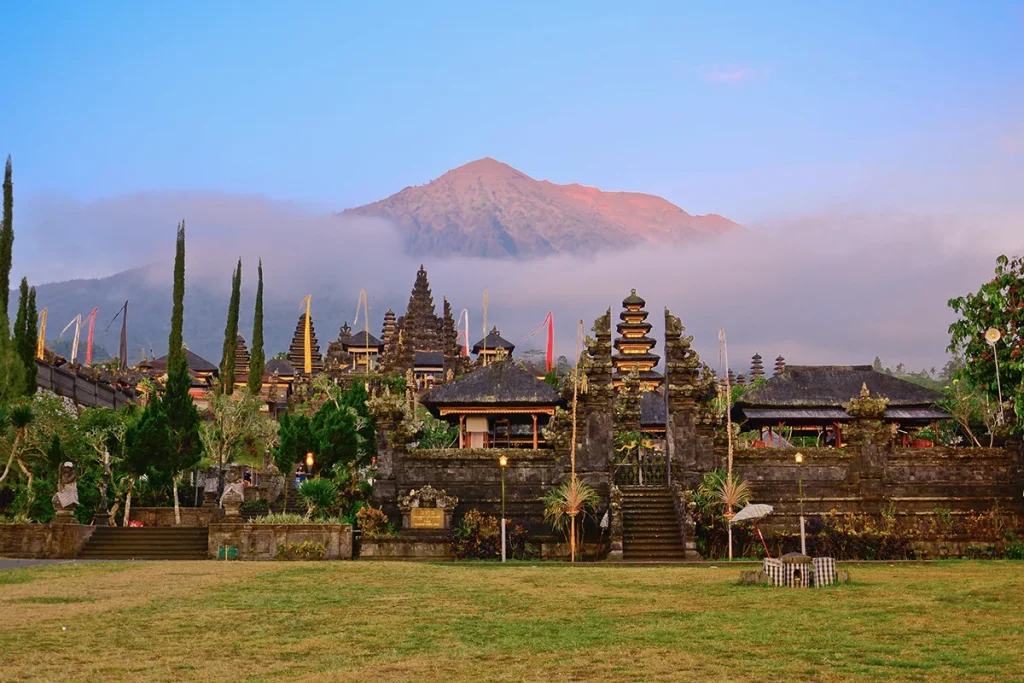
| Google Map Location | Operational hours: Everyday 07.00 – 18.00 WITA (Bali time) | Entrance fee: IDR 80,000 (domestic visitors) IDR 150,000 (foreign visitors) |
Pura Besakih is Bali’s largest and holiest temple, located on the slopes of Mount Agung. This sprawling complex of 23 temples is the spiritual heart of Balinese Hinduism. Its intricately designed architecture, deeply sacred ceremonies, and breathtaking views of the surrounding mountains make it a cultural landmark that embodies the island’s rich spiritual heritage.
Perched at an altitude of 900 metres and facing the highest peak of Mount Agung, which is believed to be the dwelling place of the gods, Pura Besakih holds profound religious importance. The temple is situated in the village of Besakih in eastern Bali, and its name is rooted in the word “Basuki,” derived from the Sanskrit term “Wasuki,” meaning salvation. In Balinese mythology, this name is connected to the dragon-god Naga Besukian, who is said to inhabit Mount Agung, the island’s most revered volcano.
Pura Besakih has been regarded as a sacred site since ancient times, with the earliest known reference dating back to 1007 AD. By the 15th century, it had become the central temple of Hinduism in Bali, a testament to its enduring significance in Balinese religious life.
At the heart of the complex is Pura Penataran Agung, or the “Great Temple of State.” This central place of worship consists of 22 temples spread across six terraces, rising majestically along parallel ridges. As you walk through the temple grounds, you are immersed in the timeless spirituality and cultural richness that define Bali.
2. Uluwatu Temple
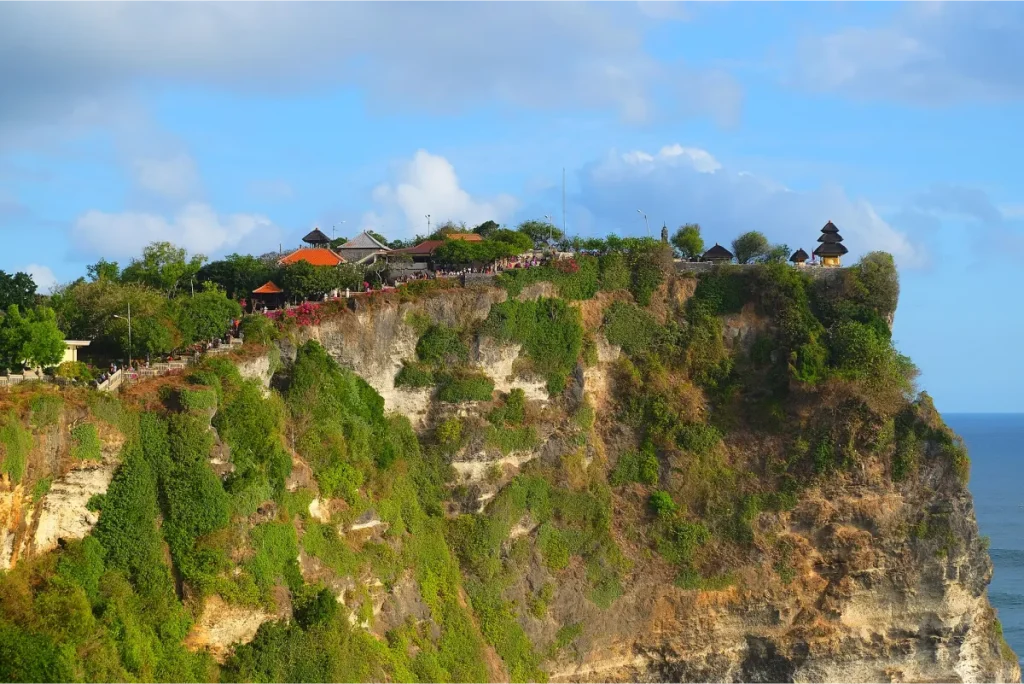
| Google Map Location | Operational hours: Everyday 07.00 – 19.00 WITA (Bali time) | Entrance fee (Temple):Domestic IDR 15,000 (Children) IDR 30,000 (Adults) Foreigner IDR 20,000 (Children) IDR 50,000 (Adults) |
I can confirm that Uluwatu Temple is truly impressive in terms of both its architecture and spiritual significance. Sitting boldly on a cliff 97 metres above the expansive Indian Ocean, Uluwatu is not only a stunning sight to behold. You will have an amazing experience of Bali’s cultural heritage, particularly when you observe the mesmerising Kecak dance during a beautiful sunset.
The position of the temple holds great importance. Constructed on the extreme edge of the cliff, known as “ulu,” this temple gets its name, with “watu” translating to rock. Local legends claim that this rock is a fragment of Dewi Danu’s fossilised boat, enhancing its picturesque location with a touch of mysticism.
While there may have been a small temple present before, the location became more important in the 11th century with the expansion of the structure by Empu Kuturan, a wise man from Java. In the 16th century, Dang Hyang Nirartha brought the padmasana shrines to this place, where he is said to have achieved moksha. The reason for the temple’s full name, Pura Luhur Uluwatu, stems from the significant occasion known as “ngeluhur” or “to go up.”
The temple is also the residence of a fun-loving yet naughty group of long-tailed macaques. Although they contribute to a vibrant environment, it is important to be careful with your possessions as these monkeys have a reputation for grabbing things. It’s fascinating how they can be tempted with fruit or snacks to give back your belongings, but be cautious as this could reinforce their mischievous behavior!
One of the main attractions when you visit Uluwatu Temple is watching the Kecak dance show that takes place every day. The strong dance, happening on the cliff at 6 PM, narrates a tale from the Ramayana, as dancers sing in harmony as the sun sets dramatically in the background. It’s among the most iconic cultural experiences you can participate in.
3. Tirta Empul Temple
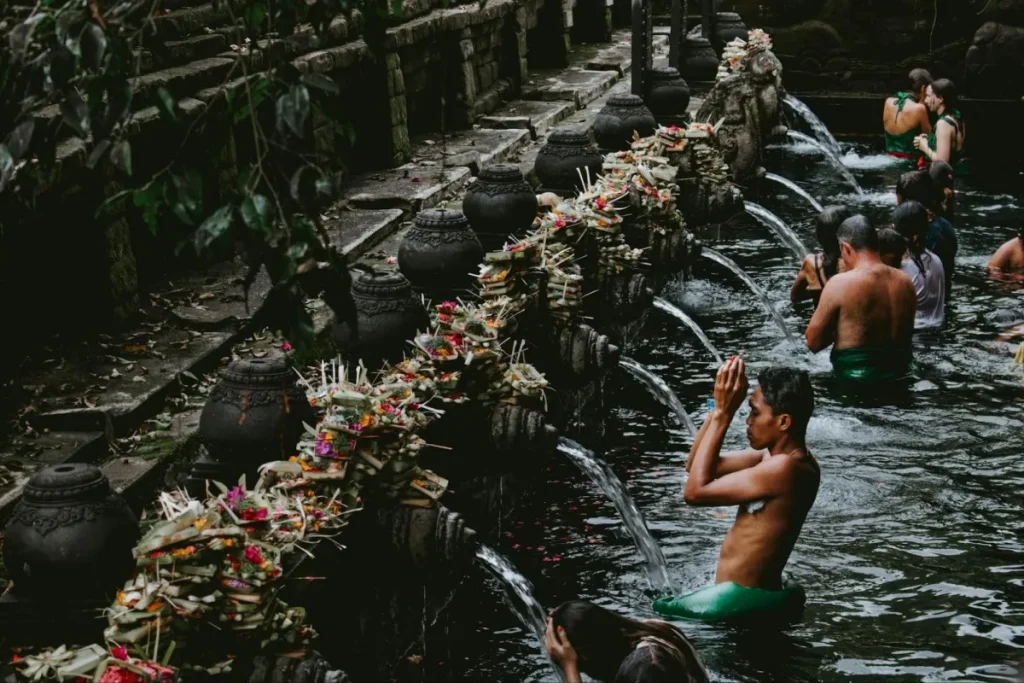
| Google Map Location | Operational hours: Everyday 07.00 – 18.00 WITA (Bali time) | Entrance fee: IDR 25,000 (Children) IDR 50,000 (Adults) |
Tirta Empul, established in the year 926, continues to be a lively and holy site for worship, drawing in residents and visitors alike. Guests are not just invited to appreciate the temple’s beauty, but they can also engage in purification rituals, providing insight into Bali’s spiritual traditions.
Situated in the village of Manukaya, Tirta Empul is found near Tampaksiring and in proximity to Ubud, within the Gianyar Regency, below the Presidential Palace of Tampaksiring. Constructed in 1957 by Indonesia’s inaugural president, Soekarno, the palace stands as a prominent feature of Bali and the country, providing a beautiful setting to the peaceful environment of the temple. The palace and the temple combine to offer some of the most stunning sights on the island.
Tirta Empul is a holy bathing centre, also known as a Petirtaan, that features a large complex which requires at least 30 minutes to an hour to fully explore. Similar to other holy places in Bali, guests must wear a sarong before they can enter, and they have the option to rent one for a small fee at the entrance.
Upon entering the temple, you go through a massive stone Candi Bentar gate before reaching the jaba sisi, also known as the outer courtyard. Another Candi Bentar gate is located past this courtyard, providing access to the central courtyard. These intricately carved statues of two Dwarapala guard the entrance, adorned with gold accents. High on the gateway, there is a portrayal of Kala, a customary Balinese character, recognized for its upward-pointing fangs and welcoming hands—unique attributes rarely seen in other Kala carvings on the island.
Exploring Tirta Empul offers an opportunity to engage with Bali’s spiritual and architectural legacy, making it an essential stop for those intrigued by the island’s diverse cultural environment.
4. Goa Gajah (Elephant Cave)
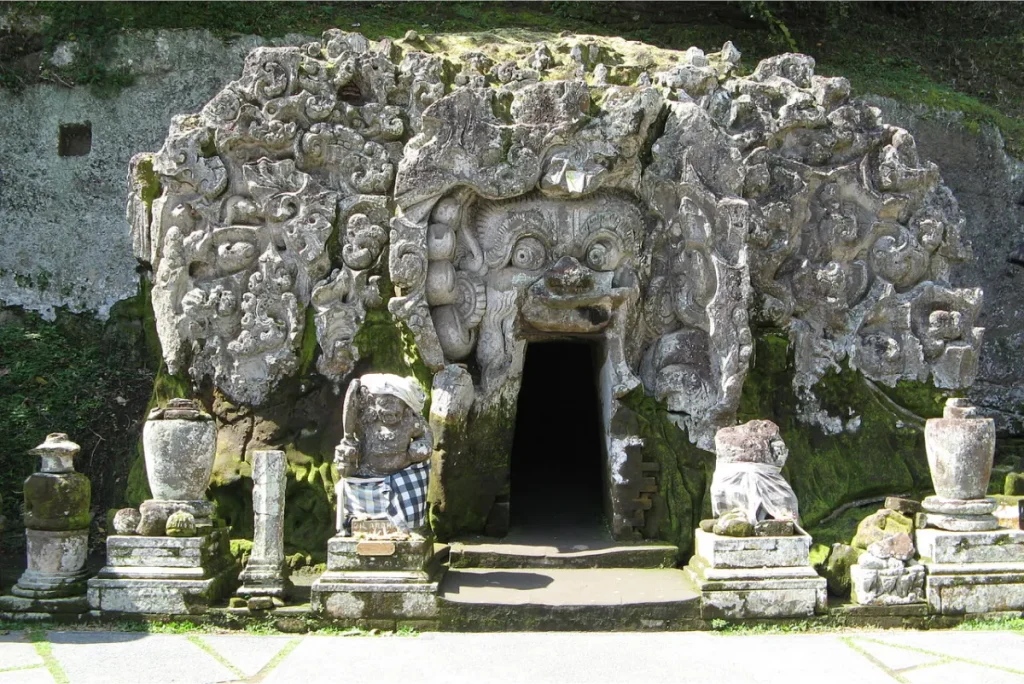
| Google Map Location | Operational hours: Everyday 08.00 – 18.00 WITA (Bali time) | Entrance fee: Domestic IDR 15,000 (Children) IDR 30,000 (Adults) Foreigner IDR 25,000 (Children) IDR 50,000 (Adults) |
Goa Gajah, also known as “The Elephant Cave,” is a significant cultural and spiritual landmark located near Ubud, Bali. Built in the 9th century, it originally served as a sanctuary for meditation and remains a revered site today. While its precise origins are unclear, one local folklore attributes its creation to the legendary giant Kebo Iwa, who is said to have carved the cave with his fingernail. However, based on its architectural style, it likely dates back to the 11th century during the Bali Kingdom era.
The Goa Gajah complex is notable for its blend of Hindu and Buddhist influences. Inside the cave, visitors can find symbols of Shiva—such as the lingam and yoni—as well as a statue of Ganesha, the Hindu god with the head of an elephant. By the river, carvings of stupas and chattra, iconic Buddhist symbols, add to the site’s spiritual diversity.
Rediscovered by Dutch archaeologists in 1923, Goa Gajah revealed even more of its secrets when the bathing pool and fountains were uncovered in 1954. The cave is best recognized for its menacing stone carvings, which are believed to ward off evil spirits. While the cave’s name, “Elephant Cave,” was initially thought to refer to the figure of an elephant carved into the stone, it may also be linked to the statue of Ganesha inside.
The site is mentioned in the 14th-century Javanese poem Desawarnana, emphasising its historical importance. The bathing area features seven statues of women holding water pitchers, symbolising the seven sacred rivers of India—Ganga, Sarasvati, Yamuna, Godavari, Sindhu, Kaveri, and Narmada. Sadly, one of these statues was damaged by an earthquake, but the site remains a powerful symbol of Bali’s spiritual heritage.
Visitors access the cave by descending a long flight of stairs, and those wearing shorts are required to wear a sarong before entering the courtyard, which is a common practice at Bali’s sacred sites. Inside the small, smoky temple, incense burns continually, adding to the sense of reverence and tranquillity.
Although Goa Gajah was added to UNESCO’s World Heritage Tentative List in 1995, it was withdrawn along with 11 other sites in 2015. Nevertheless, it remains a culturally rich destination that offers a unique glimpse into Bali’s spiritual and architectural history.
5. Gunung Kawi Temple
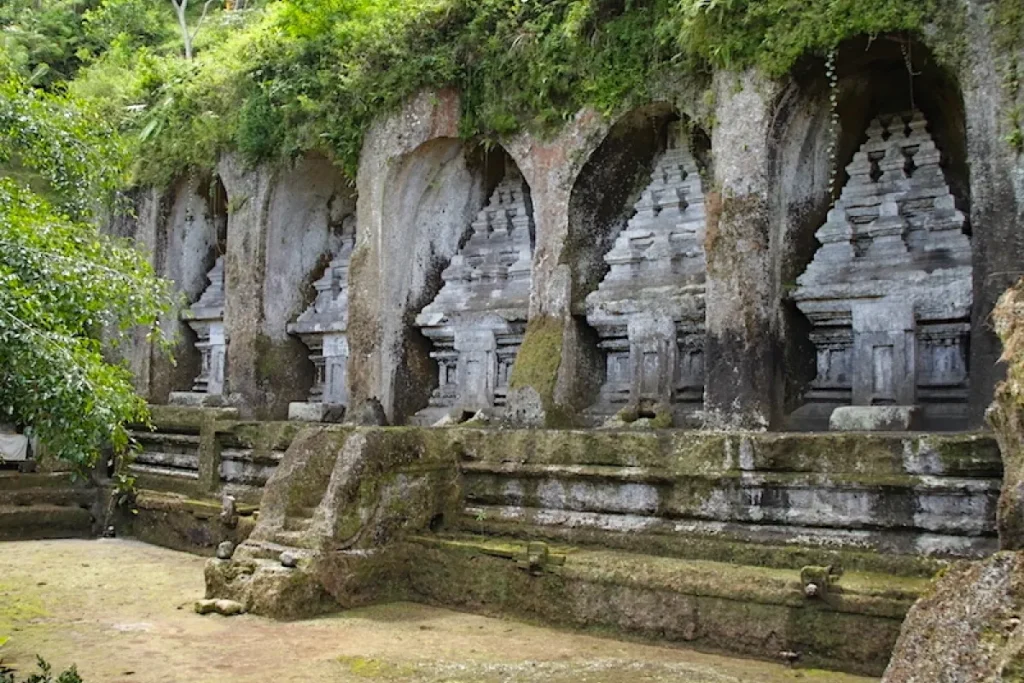
| Google Map Location | Operational hours: Everyday 08.00 – 18.00 WITA (Bali time) | Entrance fee: IDR 25,000 (Children) IDR 50,000 (Adults) |
Gunung Kawi Temple is one of Bali’s most captivating archaeological sites, nestled along the cliffs of the Pakerisan River in Tampaksiring. What makes this temple truly extraordinary is that it is carved directly into the sandstone cliffs, creating a series of shrines that blend harmoniously with the natural landscape. The intricate carvings and historical significance of this temple make it both a cultural and spiritual treasure.
The temple holds deep historical importance as it is believed to be a sacred resting place for Bali’s royalty, specifically for King Anak Wungsu, the son of King Udayana. King Udayana, along with his queen Gunapriya Dharmapatni, had three sons. The eldest, Airlangga, became the king of Kediri in East Java, while the other two, Marakata and Anak Wungsu, ruled Bali. After King Udayana passed away, his second son Marakata took the throne in 1025 A.D., and later, Anak Wungsu became king in 1049 A.D., ruling until 1080 A.D.
The kings, after their passing, were enshrined in the majestic Gunung Kawi Temple. On the temple walls, inscriptions have been found that shed light on its history. One of the most significant is the Kediri Kwadrat inscription, which reads “Haji Lumah ing Jalu,” meaning “the king who was enshrined in Jalu,” a reference to King Udayana. Another inscription, found in the second temple, reads “Rwa nak ira”, which translates to “his two sons,” suggesting that this part of the temple is the final resting place of Udayana’s sons.
Adding to its historical richness is the Tengkulak inscription, dating back to 945 Saka (1023 A.D.), which tells of a hermitage known as Amarawati, located near the Pakerisan River. This inscription solidifies the area’s sacred status, referring to it as the Gunung Kawi Tampaksiring Temple complex. Beyond being a royal burial site, Gunung Kawi has also served as a centre for spiritual and religious training for centuries.
One of the unique features of this temple is the Campuhan, or the confluence of two rivers, the Pakerisan River and the Bulan River, located in the southern part of the complex. In Hindu belief, this meeting of rivers is considered a place of self-purification, where people come to cleanse their spirit. To this day, the sacred Tirta, or holy water, from Gunung Kawi is still used by the local community for religious ceremonies, maintaining the temple’s role as a vital center of spiritual practice.
Visiting Gunung Kawi Temple is like stepping back in time, where the beauty of nature, history, and spirituality converge into one unforgettable experience. It stands as a testament to Bali’s rich cultural heritage and its deep connection to its royal lineage and religious traditions.
6. Taman Ayun Temple
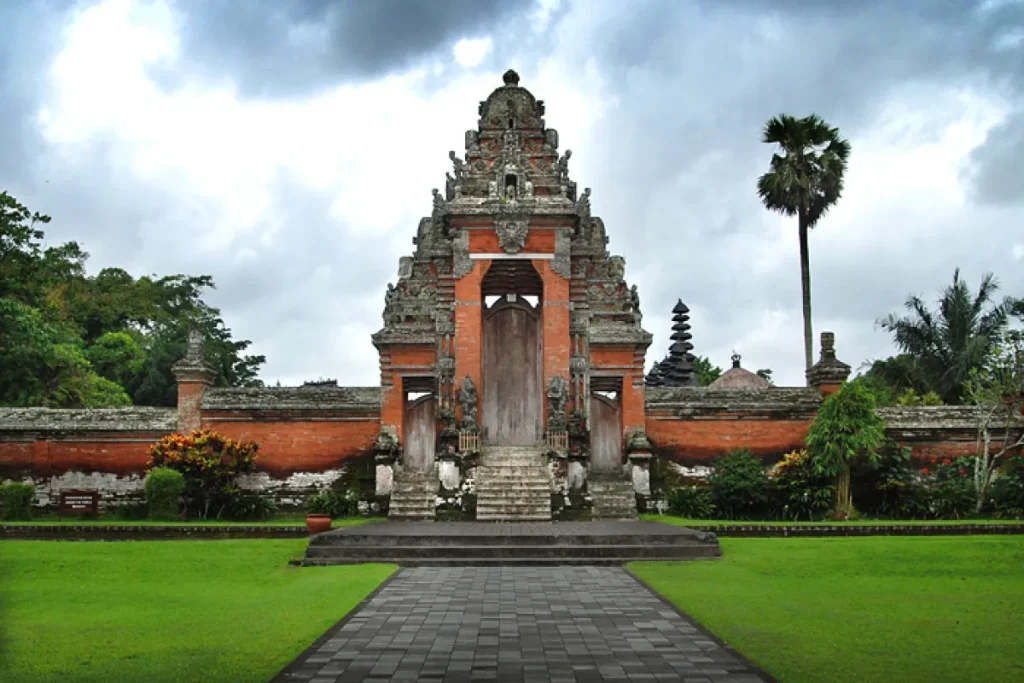
| Google Map Location | Operational hours: Everyday 08.00 – 18.00 WITA (Bali time) | Entrance fee: Domestic IDR 10,000 (Children) IDR 15,000 (Adults) Foreigner IDR 15,000 (Children) IDR 30,000 (Adults) |
Pura Taman Ayun, located in the district of Mengwi in Badung Regency, is one of Bali’s most impressive temples, renowned for both its cultural significance and stunning beauty. Meaning “beautiful garden,” Taman Ayun is the second-largest temple in Bali, covering a vast area of 6.9 hectares. It’s a true gem nestled in the heart of Mengwi, just 19 kilometres north of Denpasar.
Built in 1634 A.D. by the King of Mengwi, Gusti Agung Putu (also known as Cokorda Sakti Blambangan), this temple was originally constructed as a pura kawitan, a family temple to honour the spirits of the Mengwi royal ancestors. Over the centuries, the temple has undergone several renovations, including one in 1750 by an architect named Hobin Ho, and the most recent significant restoration took place in 1937.
One of the most striking features of Taman Ayun is its unique layout. Like other Balinese temples, it is divided into three distinct courtyards: the outer courtyard (jabaan or Nista Mandala), the middle courtyard (jaba tengah or Madia Mandala), and the inner sanctuary (jeroan or jaba jero, or Utama Mandala). These sections are separated by Candi Bentar, or split gates, which add to the temple’s architectural grandeur. In the inner sanctuary, the shrines tower at various heights, with some rising up to eleven tiers, honouring both Hindu gods and the royal ancestors.
Water plays an integral role in the temple’s design, surrounding the compound like a massive moat. This water feature is not only aesthetically beautiful but also crucial to the local subak irrigation system, which feeds the surrounding rice paddies. The temple’s waters are said to sustain three subaks in the Badung Regency, making it an important part of Bali’s agricultural and spiritual landscape.
In 2012, Pura Taman Ayun was recognized as a UNESCO World Heritage Site, under the cultural category of Bali’s Subak System and the philosophy of Tri Hita Karana, which emphasises the balance between humanity, nature, and the divine. This global recognition highlights the temple’s significance, both in terms of its cultural heritage and its role in supporting sustainable agriculture in Bali.
Beyond its sacred courtyards, Taman Ayun also offers a variety of cultural attractions. An art gallery and theatre within the complex provide insights into the temple’s history and its connection to the Mengwi royal family.
The Ogoh-Ogoh Museum, located just outside the compound, displays the demon figures used in Bali’s Ngrupuk parade before Nyepi, the Balinese Day of Silence. Nearby, the Yadnya Museum showcases replicas of traditional Balinese Hindu rituals, offering visitors a deeper understanding of the island’s religious traditions.
Whether for its serene beauty, its historical importance, or its role in Bali’s unique Subak irrigation system, Pura Taman Ayun stands as a must-visit landmark that reflects the harmonious balance of culture, spirituality, and nature.
7. Sacred Monkey Forest Sanctuary
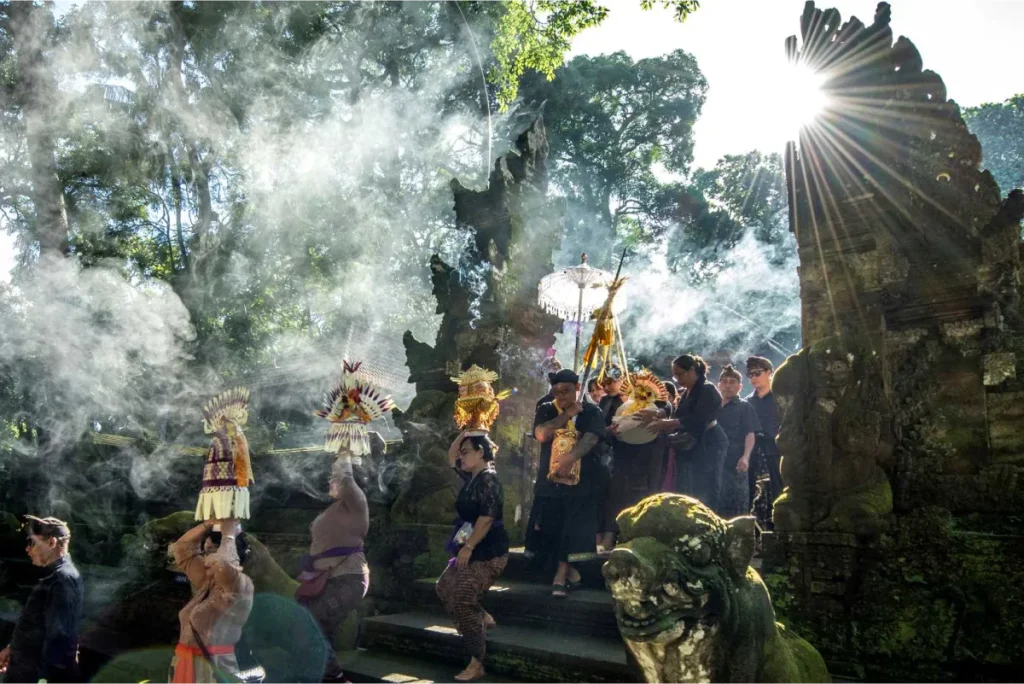
| Google Map Location | Operational hours: Everyday 09.00 – 18.00 WITA (Bali time) | Entrance fee: Domestic IDR 10,000 (Children) IDR 15,000 (Adults) Foreigner IDR 15,000 (Children) IDR 30,000 (Adults) |
The Sacred Monkey Forest Sanctuary, also known as the Ubud Monkey Forest, is a natural sanctuary located in the village of Padangtegal in Ubud, Bali. The forest covers approximately 12.5 hectares and is home to over 1200 long-tailed macaque monkeys.
Monkey Forest Ubud holds a significant history intertwined with Balinese culture. Dating back to the 14th century, it has been regarded as a sacred place, housing spiritual forces and guardian spirits. The monkeys, seen as sacred animals, symbolise both protection and mischief, fostering a unique connection between humans and wildlife.
In the 20th century, Monkey Forest Ubud gained recognition as a vital conservation area. Efforts were made to preserve its natural beauty, promote responsible tourism, and raise awareness about the cultural and environmental significance. Today, it stands as a cherished sanctuary, where visitors can connect with nature, observe captivating monkey behaviour, and support the ongoing conservation efforts.
8. Pura Ulun Danu Beratan
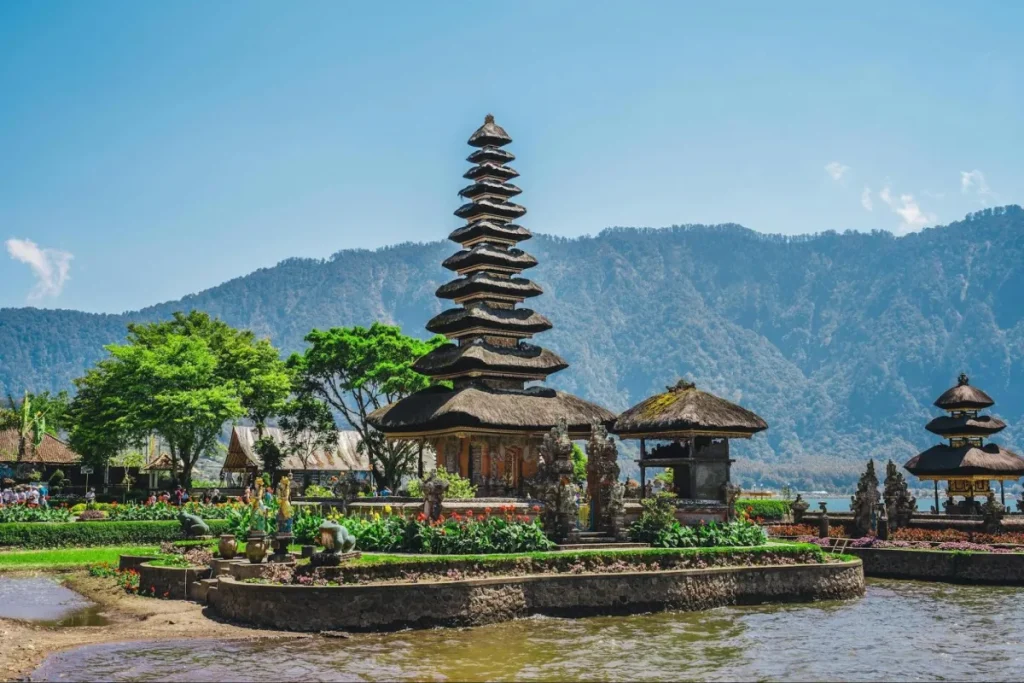
| Google Map Location | Operational hours: Everyday 07.00 – 19.00 WITA (Bali time) | Entrance fee: Domestic IDR 20,000 (Children) IDR 40,000 (Adults) (Weekdays) IDR 50,000 (Adults) (Weekends) Foreigner IDR 50,000 (Children) IDR 75,000 (Adults) |
In the cool highlands of Bali’s Bedugul Regency, standing on a plateau overlooking the serene waters of Lake Beratan, is the breathtaking Ulun Danu Beratan Temple. Situated about 1,500 metres above sea level, the temple enjoys a mild and crisp climate, with the calm, clear lake surrounding it. The scene is often enveloped by a gentle mist rising from the lake, giving the temple an almost otherworldly appearance as it seems to float above the water.
Pura Ulun Danu was constructed to honour Goddess Danu, the revered queen of water, lakes, and rivers in Balinese culture. The word “Danu” itself means “lake,” reflecting the temple’s deep connection to the surrounding natural elements. The temple complex comprises four sacred structures, each dedicated to different deities. The Linga Pura stands three levels high in devotion to Shiva, while Pura Puncak Mangu, rising eleven levels, is dedicated to Vishnu. The Pura Teratai Bang serves as the main temple, and Pura Dalem Purwa is dedicated to Sang Hyang Widhi, the supreme god. The latter temple is also a place where people come to pray for fertility, prosperity, and well-being.
Ulun Danu Temple follows the Trimurti belief, which worships three principal Hindu gods: Brahma, Vishnu, and Shiva. Each god is represented by a sacred colour—red for Brahma (The Creator), black for Vishnu (The Preserver), and white for Shiva (The Destroyer). This symbolism is reflected in the architecture and religious practices of the temple.
The surrounding area has been a spiritual site since the megalithic period, and nearby there are ancient relics, such as a sarcophagus and a stone slate, dating back to around 500 BC. The temple itself is believed to have existed as early as 1556, though it was rebuilt in 1633 by the King of Mengwi, I Gusti Agung Putu. Its architecture blends Hindu and Buddhist influences, adding to its cultural richness. Despite its centuries of existence, Ulun Danu Temple is meticulously maintained by the local community and remains in pristine condition.
As a cultural icon, Ulun Danu Temple is recognized as one of Bali’s most important landmarks. In fact, it is so significant that it is depicted on the 50,000 rupiah bill, further cementing its status as a symbol of Balinese spirituality and heritage.
9. Penglipuran Traditional Village
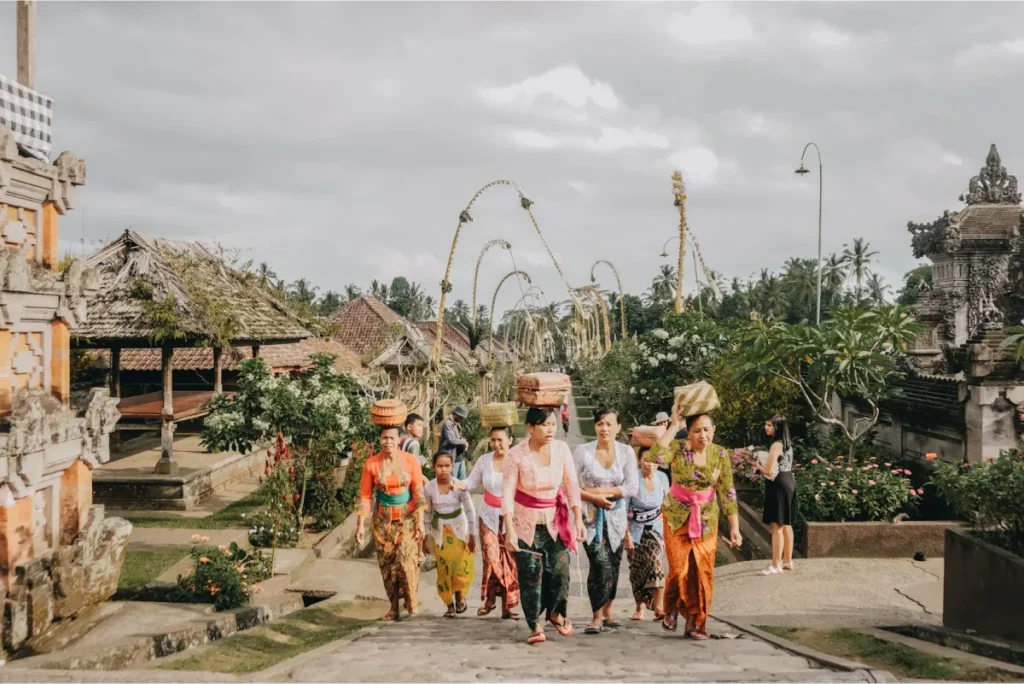
| Google Map Location | Operational hours: Everyday 08.00 – 18.30 WITA (Bali time) | Entrance fee: Domestic IDR 15,000 (Children) IDR 25,000 (Adults) (Weekdays) Foreigner IDR 30,000 (Children) IDR 50,000 (Adults) |
Nestled in the Bangli Regency of Bali, Penglipuran Village stands as a beacon of traditional Balinese culture, where daily life reflects an enduring commitment to preserving ancient customs. This village has become a popular tourist destination, known for its well-preserved architecture and adherence to the Tri Hita Karana philosophy, which emphasises the harmonious relationship between humans, nature, and the divine. Penglipuran is a rare example of a community that has embraced tourism while maintaining its cultural integrity.
The village’s unique layout and building structures follow traditional Balinese principles, with the homes, roads, and landscapes all reflecting a balance between function and spiritual beliefs. In 1995, Penglipuran earned the prestigious Kalpataru Award from the Indonesian government for its conservation efforts, particularly its work to protect the local bamboo forest. This bamboo ecosystem is an essential part of the village’s environment and plays a key role in local life.
Penglipuran Village is located approximately 5 kilometres north of Bangli and about 45 kilometres northeast of Denpasar, surrounded by other traditional villages such as Kayang to the north, Kubu to the east, and Gunaksa to the south. The village spans an area of 112 hectares and is situated at an altitude of 500-600 metres above sea level, providing a cool climate with temperatures ranging between 16-29 degrees Celsius. The region receives around 2000 mm of rainfall annually, and its flat terrain makes it ideal for the traditional Balinese lifestyle.
The history of Penglipuran dates back to the reign of I Dewa Gede Putu Tangkeban III, and most of the villagers believe their ancestors came from the nearby village of Bayung Gede. The people of Bayung Gede were known for their expertise in religious and cultural matters, and they were often called upon by the Bangli Kingdom for their skills. To make their travels easier, the kingdom provided a temporary resting place, which eventually became the settlement known today as Penglipuran. The close ties between the two villages are reflected in their similar customs and architectural styles.
As for the name Penglipuran, there are two prevailing theories about its origin. The first suggests that the name comes from “pengeling pura,” which means “to remember the temple” or “the ancestral place,” reflecting the village’s deep connection to its spiritual roots. The second theory interprets “penglipuran” as a combination of “pelipur” (comfort) and “lipur” (unhappiness), meaning “a place for consolation.” According to legend, the King of Bangli would often visit the village to meditate and find solace, lending weight to this interpretation.
Today, Penglipuran remains a symbol of living tradition in Bali, where the community thrives by blending its cultural heritage with modern tourism, offering visitors a unique glimpse into the island’s ancient way of life.
10. Bali Aga Villages
10.1. Trunyan Village
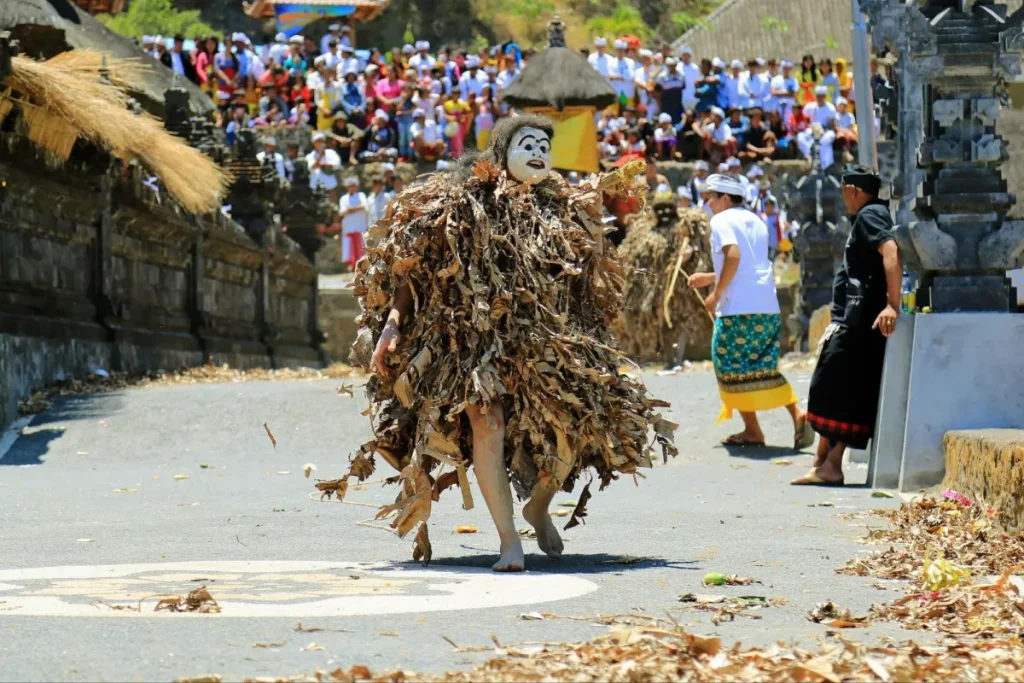
| Google Map Location | Operational hours: Everyday 24/7 | Entrance fee: N/A |
Located on the eastern shore of Lake Batur in Bangli Regency, Bali, the village of Trunyan is one of the most distinctive communities of the Bali Aga people, known for preserving ancient traditions that predate the arrival of Hinduism and Buddhism on the island. Alongside Tenganan and Sambiran, Trunyan is one of the few remaining culturally isolated Bali Aga villages, set against the backdrop of Mount Abang and only accessible by boat.
What sets Trunyan apart is its unique funeral tradition, where deceased bodies are not cremated or buried in the ground, as is common in other parts of Bali. Instead, the dead are laid out in the open, simply covered with cloth and bamboo canopies, and left to decompose. Remarkably, no foul smell is present because of the Taru Menyan tree, an ancient banyan tree nearby, which emits a fragrance that neutralises the odour of the decomposing corpses. It is from this tree that the village derives its name, as Taru Menyan translates to “nice-smelling tree.” When the bodies have fully decomposed, the skulls are arranged on a stone altar, located 500 metres north of Banjar Kuban, a site that can only be reached by boat. However, this unique burial rite is reserved exclusively for married individuals; unmarried people are buried in a cemetery instead.
Trunyan’s cultural and historical significance extends far beyond its funeral practices. The village dates back to at least the 10th century AD, according to copperplate inscriptions found in the village’s main temple. The temple, dedicated to Bhatara da Tonta, has roots in the 833 saka (10th century AD). However, evidence of much older human activity has been discovered in Trunyan, with lithic tools indicating the presence of a hunter-gatherer society long before the establishment of the temple.
The Trunyanese society is divided into two main castes, banjar jero and banjar jaba, tracing their lineage to the Gelgel dynasty. The banjar jero consists of descendants of those appointed by the kings of Gelgel to rule, while the banjar jaba are descendants of those ruled by the banjar jero. Despite the village’s isolation, these influences, along with the requirement for young men to spend time in lowland Bali as beggars—similar to Buddhist monks—show how outside customs have filtered into Trunyan’s deeply rooted traditions.
Another important aspect of Trunyan life is its emphasis on prestige and lavish ceremonies. Major events like weddings are expected to be extravagant, and many families postpone these ceremonies due to the high costs involved, despite having children already. This focus on ceremonial grandeur is similar to other Balinese customs, yet Trunyan’s unique isolation and economy, which is based on small-scale agriculture, makes it challenging to accumulate the wealth needed for such events.
Trunyan offers a window into Bali’s ancient past, where ancient traditions meet the mystical power of nature, and the spiritual life of the community is intertwined with their unique relationship to the environment and their ancestors. The village’s distinct customs, particularly in the handling of death, make it one of the most fascinating and culturally significant places in Bali.
10.2. Tenganan Village
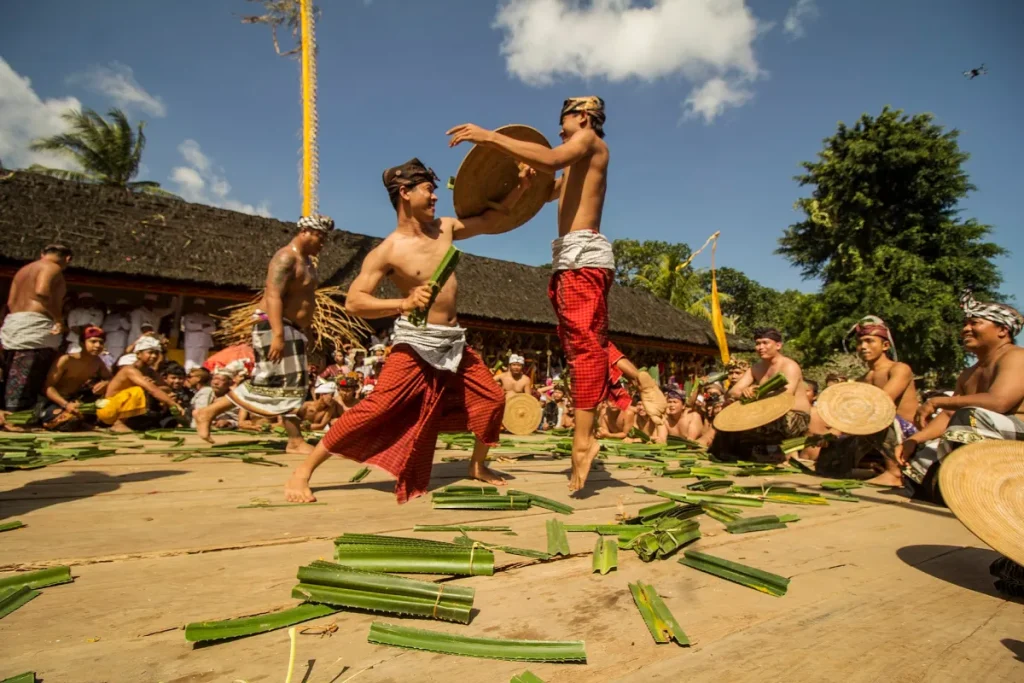
| Google Map Location | Operational hours: Everyday 24/7 | Entrance fee: N/A |
Located in Karangasem Regency in East Bali, Indonesia, Tenganan Pegringsingan is a traditional village renowned for its unique gringsing (also known as geringsing) textiles and gamelan selunding music. The gringsing, a form of double ikat textile, is one of only three types of this weaving technique found in the world. The gamelan selunding or Gambelan selonding music is played on iron metallophones, adding to the village’s cultural richness.
Historically, before the 1970s, Tenganan was known by anthropologists as one of the more secluded societies in the Indonesian archipelago. However, since that time, various changes have transformed the village, such as improvements in local communication by the central government, the opening up to tourism, and changes to the traditional endogamic rules (rules governing marriage within a specific group).
Tourists are drawn to Tenganan for its Bali Aga culture, which still adheres to ancient Balinese traditions, ceremonies, and rules. The village’s layout and architecture are also distinctive, adding to its appeal. According to local legend, the village’s people were chosen by the Hindu god of storms and warfare, Indra, to administer their territory following a divine plan designed to be a microcosm of the world. The villagers were instructed to maintain the purity and cleanliness of the land, a principle that remains of utmost importance to the community.
Like the people of Trunyan village, the residents of Tenganan Pegringsingan are known as the Bali Aga, considered to be the original Balinese people. They are believed to be descendants of the pre-Majapahit kingdom of Bedahulu. Strict regulations govern life in Tenganan, particularly regarding residency and marriage. Only individuals born in the village can remain and become full members of the community, and those who marry outsiders must leave. However, as the village has come into greater contact with the outside world, these rules have relaxed somewhat.
The architecture of Tenganan Pegringsingan is noteworthy. Houses are built on either side of a concourse that runs uphill to downhill, with narrow entrances that allow only one person to pass through at a time. The village can only be entered or exited through a gate at the downhill end, near which are two small temples. Across from the gate lies the balé agung, a long pavilion where administrative decisions for the village are made. Close to the balé agung is the kul-kul, a drum tower that is beaten 21 times each morning to signal the start of the day. Up the centre of the village are several communal pavilions called balé patemon, used for both formal and informal meetings, as well as ceremonial gatherings. At the northern end of the village is Pura Puseh, the temple of origin.
11. Pura Lempuyang (The Gates of Heaven)
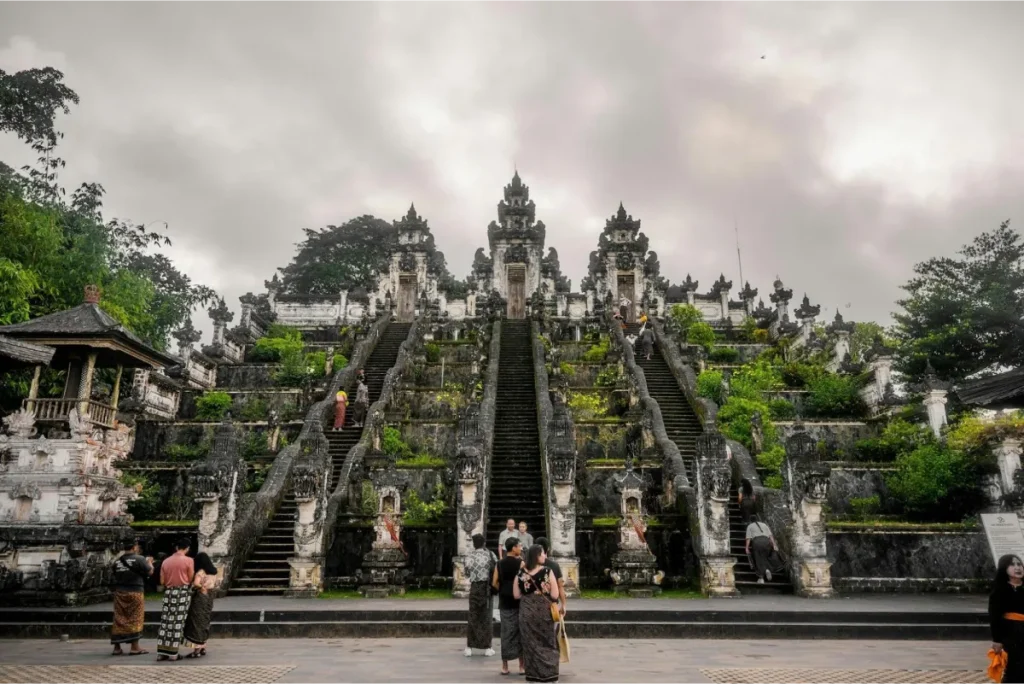
| Google Map Location | Operational hours: Everyday 07.00 – 22.00 WITA (Bali time) | Entrance fee: IDR 150,000 |
Pura Penataran Agung Lempuyang is a Balinese Hindu temple located on Mount Lempuyang in Karangasem Regency, Bali. It is the first and lowest temple in a complex of temples collectively called Pura Lempuyang. The highest temple in this complex, Pura Lempuyang Luhur, is one of Bali’s Sad Kahyangan Jagat (six holiest places of worship), and also one of the nine directional temples designed to protect the island from negative forces.
Pura Penataran Agung sits on the south-west side of Mount Lempuyang, approximately 600 metres (2,000 feet) above sea level, in the Abang district. The mountain itself is referred to as Lempuyang in Javanese, while its Balinese name is Gamongan.
Historically, the worship at Mount Lempuyang is believed to have existed long before most Hindu temples on the island of Bali were established. Two ancient epigraphs, Epigraph Sading C and Epigraph Dewa Purana Bangsul, provide insight into the spiritual history of the temple. According to Epigraph Sading C, in 1072 Caka (the Balinese lunar calendar, corresponding to 993–994 CE), Çri Maharaj Jayaçakti was instructed by his father to go to Bali and build a temple on Mount Lempuyang to ensure the island’s salvation and to encourage more people to settle in the region. The other epigraph states that Lord Paramecwara sent his son, Çri Gnijayacakti, to Bali to become the island’s protector.
In recent history, Pura Penataran Agung Lempuyang underwent restoration in 2001, further enhancing its sacred presence on the island.
The Pura Lempuyang complex features seven temples along a hiking path that leads to the summit of Mount Lempuyang. The seven temples are listed in order of elevation:
- Pura Penataran Agung Lempuyang – the lowest and first temple.
- Pura Telaga Mas – the second temple after the entrance.
- Pura Telaga Sawangan.
- Pura Lempuyang Madya.
- Pura Puncak Bisbis – the fifth temple.
- Pura Pasar Agung – the sixth temple.
- Pura Lempuyang Luhur – the highest and most sacred of the temples, located at the summit.
These temples form a significant pilgrimage path, offering visitors both spiritual and physical challenges as they ascend to the highest sanctuary.
12. Tirta Gangga Water Palace
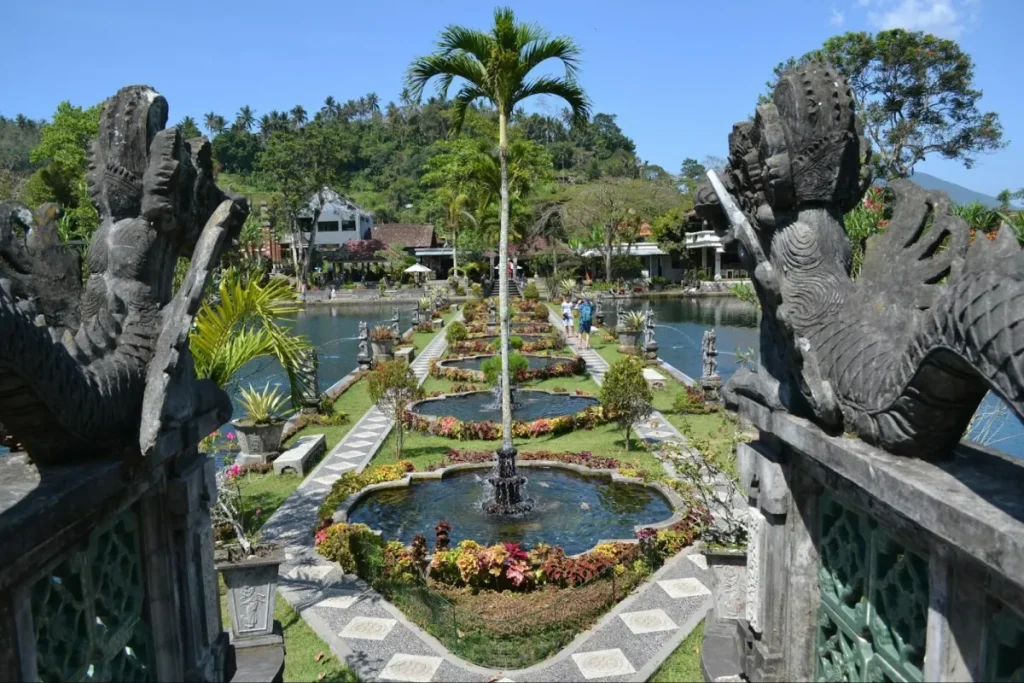
| Google Map Location | Operational hours: Everyday 06.00 – 19.00 WITA (Bali time) | Entrance fee: Domestic IDR 25,000 Foreigner IDR 40,000 |
Tirta Gangga, built by the royal family of Karangasem, is a magnificent water palace renowned for its serene environment and beautiful blend of Balinese and Chinese architectural styles. Surrounded by lush gardens, fountains, and lotus ponds, the palace offers visitors a peaceful atmosphere to explore its numerous pools and sculptures.
Located near the village of Ababi in the Abang district, Tirta Gangga is about 7 kilometres north of Amlapura (Karangasem District) and is situated to the southeast of Mount Agung. The complex was built in 1946 by the last King of Karangasem, I Gusti Bagus Jelantik, who was also responsible for the construction of the Ujung Water Palace. Originally, Tirta Gangga was a recreation area for the king and his family. However, it was almost entirely destroyed in 1963 by the eruption of nearby Mount Agung.
The temple complex covers an area of one hectare. To the northwest, on higher ground, are the springs that feed the ponds. These springs are essential not only for recreation but also for irrigation and other economic activities in the surrounding area.
In addition to its name Tirta Gangga, the palace is also known as “Taman Rijasa” (Rijasa Garden), named after the Rijasa trees (Elaeocarpus Grandiflorus) that were planted in the garden.
13. Pura Taman Kemuda Saraswati (Saraswati Temple)
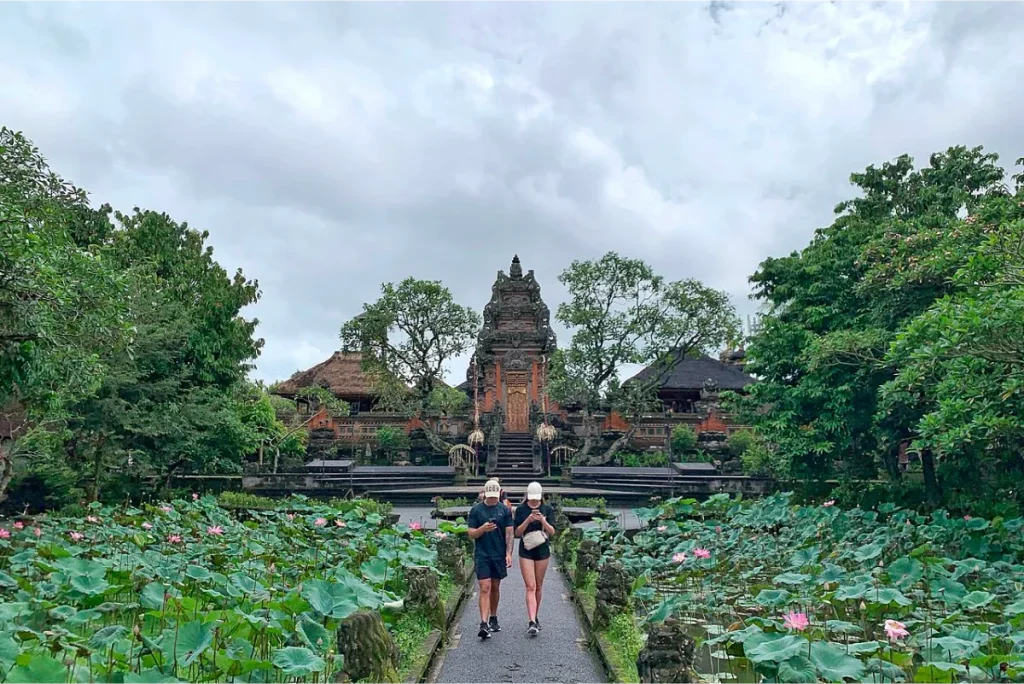
| Google Map Location | Operational hours: Everyday 08.00 – 18.00 WITA (Bali time) | Entrance fee: IDR 35,000 (Children) IDR 50,000 (Adults) |
Pura Taman Kemuda Saraswati, located in the heart of Ubud, is a Balinese Hindu temple dedicated to Saraswati, the goddess of knowledge, art, and wisdom. The temple is renowned for its beautiful lotus ponds and intricate carvings, making it an artistic masterpiece. It also serves as a cultural hub, offering visitors the chance to experience traditional Balinese dance performances in an authentic setting.
The temple was designed by I Gusti Nyoman Lempad, a famous Balinese sculptor and undagi (ritual architect). He was commissioned by Prince Cokorda Gede Agung Sukawati of Ubud, after Lempad moved to Ubud following a fallout with the King of Blahbatuh. In Ubud, he contributed to the construction of several palaces and temples in the area.
Construction of Pura Taman Kemuda Saraswati began in 1951 and was completed in 1952. The temple is dedicated to Saraswati, the Hindu deity who represents learning, literature, and the arts, symbolising the temple’s connection to Ubud’s rich cultural and artistic heritage.
14. Klungkung Royal Palace (Puri Agung Klungkung)
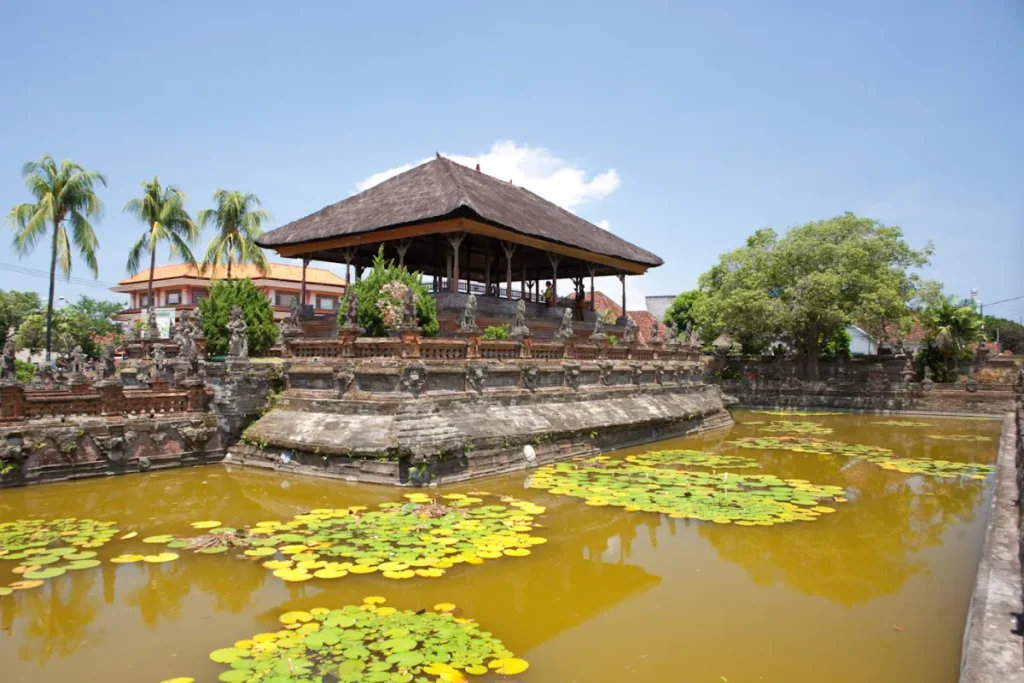
| Google Map Location | Operational hours: Everyday 10.00 – 17.00 WITA (Bali time) | Entrance fee: IDR 50,000 |
Located in Semarapura, the capital of Klungkung Regency, this historic palace complex is a symbol of the grandeur of the Klungkung Kingdom. Although much of the palace was destroyed during the Dutch invasion of 1908, several key structures still remain. Among them is the Kerta Gosa Pavilion, famous for its stunning ceiling frescoes that depict scenes from Balinese mythology.
The palace, or puri, was originally built at the end of the 17th century but was largely destroyed during the Dutch colonial conquest. Today, visitors can still see the court of justice, the Kertha Gosa Pavilion, and the main gate, which is marked with the date Saka 1622 (AD 1700). Another notable feature within the old palace compound is the floating pavilion, known as Bale Kembang.
The descendants of the rajas who once ruled Klungkung now reside in Puri Agung, a residence to the west of the old palace, built after 1929.
15. Puri Saren Agung (Ubud Royal Palace)
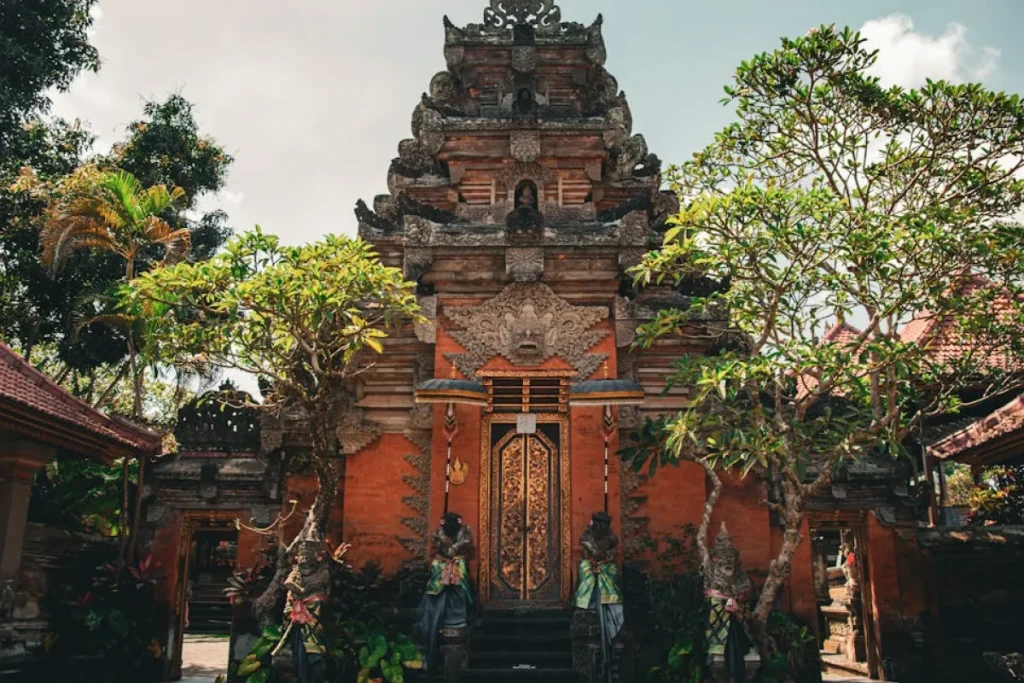
| Google Map Location | Operational hours: Everyday 07.00 – 18.00 WITA (Bali time) | Entrance fee: N/A |
The Ubud Palace, officially known as Puri Saren Agung, is a historical building complex located in Ubud, Gianyar Regency, Bali. The palace served as the official residence of the royal family of Ubud.
The palace, built in traditional Balinese architectural style, took its present form during the reign of Tjokorda Putu Kandel (1800–1823). However, it suffered major damage due to the 1917 earthquake but was quickly restored as it remained the royal residence. In 1928, the palace was opened to foreign guests.
Many of the stone carvings were created by the renowned local artist I Gusti Nyoman Lempad. The main pavilion now hosts nightly dance performances. To the north of the palace lies the pura Marajan Agung, the private temple of the royal family. The enclosure in front of the palace is home to a magnificent Bengal fig tree and is also part of the royal family’s residence.
16. Pura Samuan Tiga
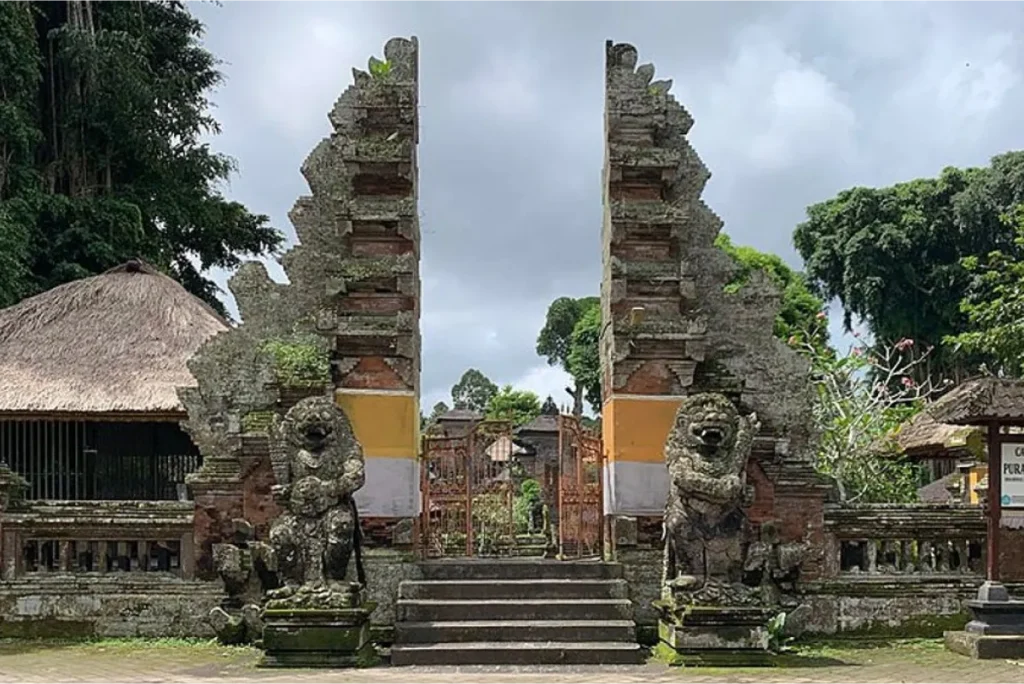
| Google Map Location | Operational hours: Everyday 06.00 – 19.00 WITA (Bali time) | Entrance fee: N/A |
The majority of the population of Bali is Hindu with the place of worship is Pura, so it is not surprising that the small island which is a world tourist destination is also known as the island of Seribu Pura, and all regencies in Bali have a number of temples that are worshipping all Hindus in Bali, one of which is the Samuan Tiga Temple located in Bedulu village, Blahbatuh District – Gianyar. This temple does have a historical background that is very important about the order of life of the Balinese people to this day.
In addition to the historical background of the founding of the Temple of Samuan Tiga which is an important part of the development of religious beliefs for Hindus in Bali, the Samuan Tiga temple is also a historical heritage which was known as Pura Samuan Tiga, this temple has been established and is called Pura Gunung Goak and some even call it the Batan Bawah Temple, well since there was a meeting between sects and produced a new agreement the place was known as the Samuan Tiga Temple.
17. Jatiluwih Rice Terraces
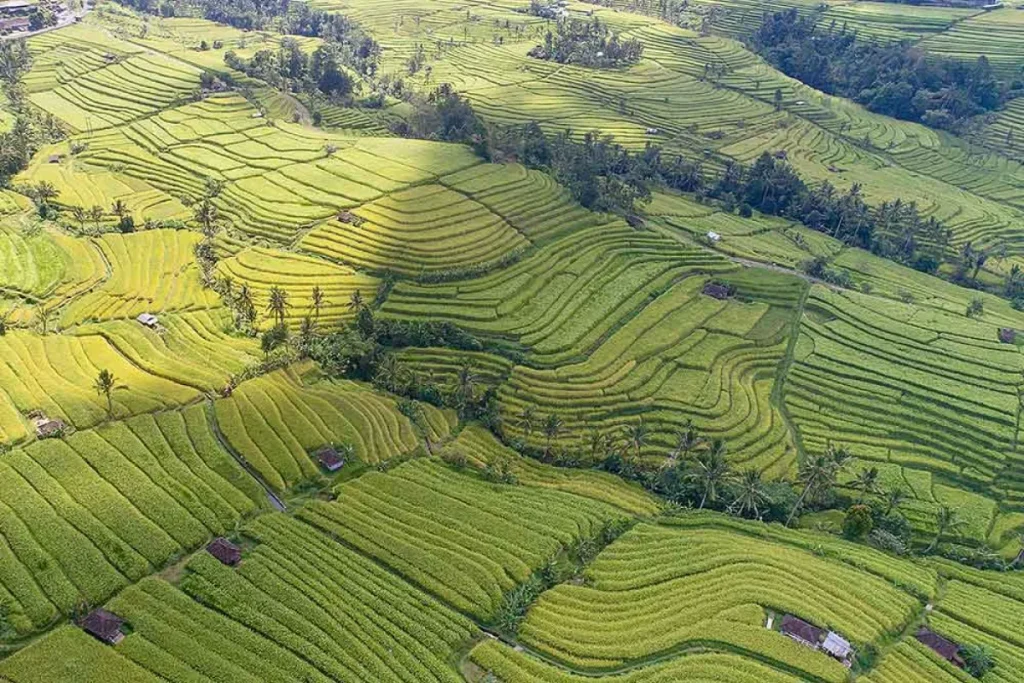
| Google Map Location | Operational hours: Everyday 08.00 – 18.00 WITA (Bali time) | Entrance fee: Domestic IDR 5,000 (Children) IDR 15,000 (Adults) Foreigner IDR 40,000 (Children) IDR 50,000 (Adults) |
Jatiluwih Rice Terraces, located in the heart of Tabanan Regency, Bali, offer a breathtaking view of lush green paddy fields cascading in terraces from the upper reaches of volcanoes down to deep valleys. These fields represent the beauty of Bali’s agricultural landscape and the island’s Subak system, a traditional method of rice field irrigation that has been passed down through generations.
In June 2012, the Jatiluwih Rice Terraces were recognized as part of Bali’s Cultural Landscape and inscribed as a UNESCO World Heritage Site. The term Jatiluwih in Balinese translates to “Beautiful Teak”, and the area is renowned for its stunning terraced paddies that stretch across the entire mountain, from its peak down to the sea.
The traditional Subak irrigation system, which is central to Bali’s agriculture, relies on the island’s 150 rivers and streams that provide year-round water. Interestingly, the Subak system is not managed by royalty but by village cooperatives, emphasising the local wisdom and the strong communal bonds among farmers. This landscape has also become a popular tourist destination, ranking among the top 10 visited places in Bali.
18. Pura Kehen
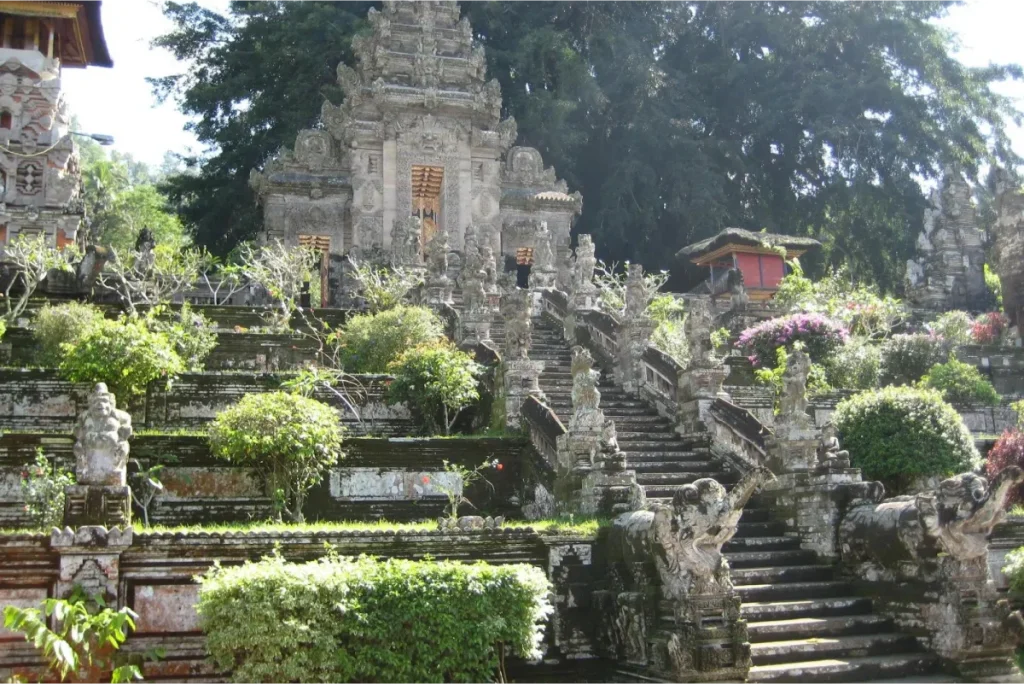
| Google Map Location | Operational hours: Everyday 08.00 – 17.00 WITA (Bali time) | Entrance fee: IDR 50,000 |
Pura Kehen, located in Cempaga, Bangli Regency, Bali, is a historical Balinese Hindu temple that served as the royal temple of the Bangli Kingdom, now the Regency of Bangli. Established at least in the 13th century, the temple is set at the foot of a wooded hill, approximately 2 kilometres north of the town centre.
The Bangli Kingdom, one of the nine kingdoms of Bali, was founded by the Gelgel Kingdom of the Majapahit dynasty. The name Bangli is derived from the term “bang giri”, meaning “red forest” or “red mountain”. The temple compound is constructed over a hilly outcrop and is aligned in a north-south direction. It is divided into three distinct sanctums: the outer sanctum (jaba pisan or nistaning mandala), the middle sanctum (jaba tengah or madya mandala), and the inner main sanctum (jero or utamaning mandala).
Visitors can access the outer sanctum via three sets of stairs from the street. The temple’s terraced landscape is adorned with stone statues representing characters from the Indian epic Ramayana, while three gateways mark the entrance into the outer sanctum, including the central paduraksa gateway, which is unusually located at the outer entrance instead of the inner main sanctum.
19. Pura Dalem Agung Padangtegal
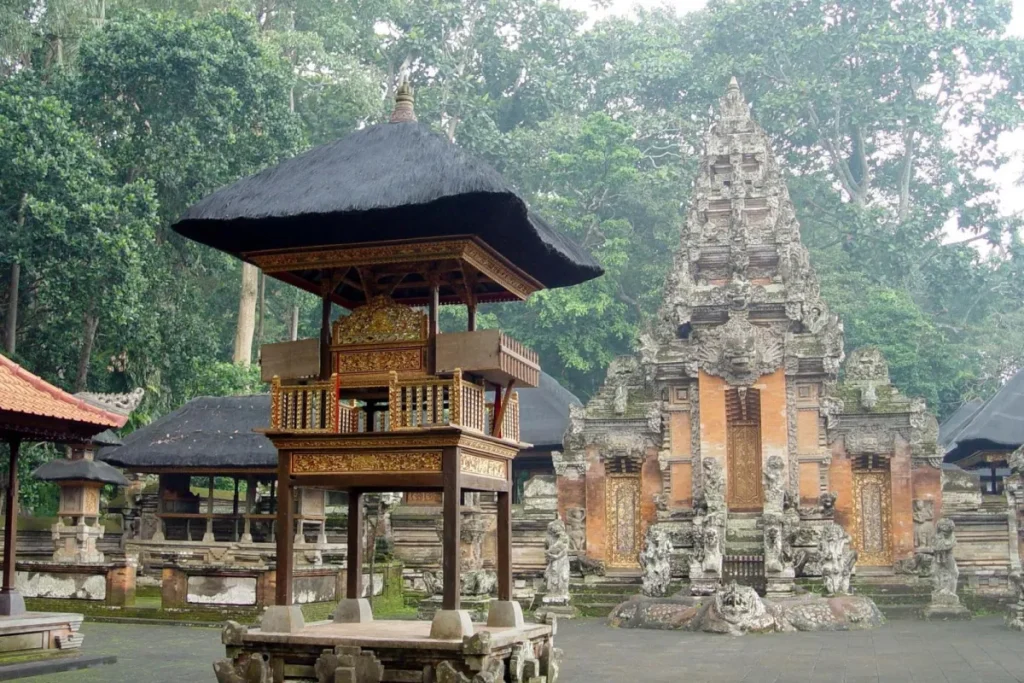
| Google Map Location | Operational hours: Everyday 08.00 – 17.00 WITA (Bali time) | Entrance fee: Free as visitors already paid for Monkey Forest’s admission fees. |
Pura Dalem Agung Padangtegal, also known as the Padangtegal Great Temple of Death, is one of three Hindu temples located within the Sacred Monkey Forest Sanctuary, often referred to as the “Ubud Monkey Forest”, in Padangtegal, Ubud, Bali, Indonesia. This temple is commonly called the “Main Temple” and is situated in the southwestern part of the forest grounds.
Dedicated to worshipping the god Hyang Widhi in the personification of Shiva, the Recycler or Transformer, the temple, like the others in the complex, is believed to have been built around 1350. This temple complex holds a significant role in the spiritual life of the local community.
In front of the temple, visitors can find the home territory of one of the five groups of crab-eating macaques that reside in the Ubud Monkey Forest.
20. Puri Lukisan Museum
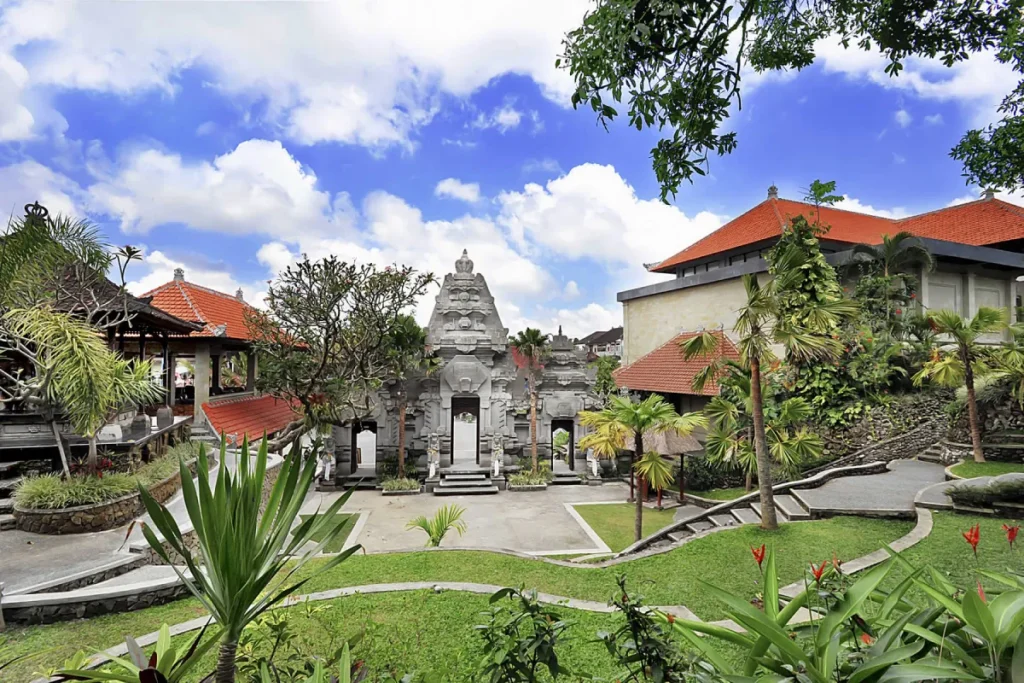
| Google Map Location | Operational hours: Everyday 09.00 – 18.00 WITA (Bali time) | Entrance fee: IDR 75,000 (Adult) |
The Puri Lukisan Ratna Wartha Museum, located in Ubud, Bali, is the oldest art museum in Bali, specialising in modern traditional Balinese paintings and wood carvings. Known as Museum Puri Lukisan Ratna Wartha in Indonesian, it houses the finest collection of modern traditional Balinese art, with pieces dating from the pre-Independence war era (1930–1945) to the post-Independence war era (1945–present).
The museum’s collection features significant works from all major Balinese artistic styles, including the Sanur, Batuan, Ubud, Young Artist, and Keliki schools, making it a key cultural destination for those interested in Balinese art history.
21. Tanah Lot Temple
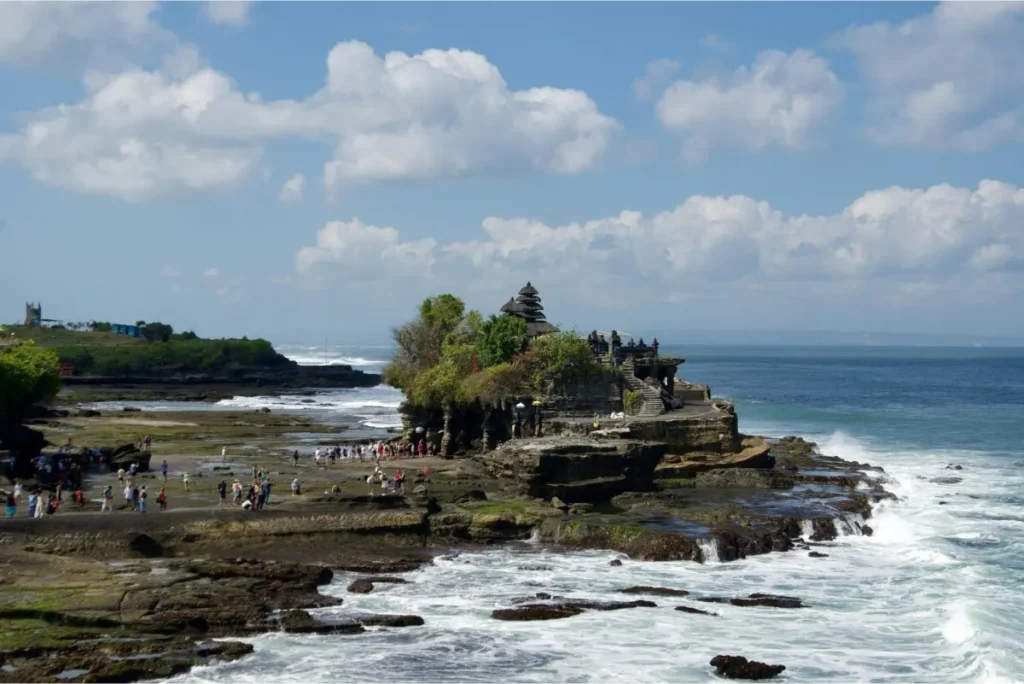
| Google Map Location | Operational hours: Everyday 06.00 – 19.00 WITA (Bali time) | Entrance fee: Domestic IDR 20,000 (Children) IDR 30,000 (Adults) Foreigner IDR 40,000 (Children) IDR 75,000 (Adults) |
Tanah Lot, a sea temple, is famous for its stunning location on a rocky outcrop off Bali’s southwestern coast. Known for its captivating sunsets, the temple is believed to protect the island from evil sea spirits.
Located in Beraban, Tabanan Regency, around 13 kilometres south of Tabanan and 20 kilometres northwest of Denpasar, Tanah Lot can only be reached on foot during low tide. The name “Tanah Lot” means “Land in the Sea” in Balinese. The temple’s main deity is Dewa Baruna or Bhatara Segara, the sea god.
Dang Hyang Nirartha, a 16th-century religious figure, is credited with establishing the temple, and he is said to have initiated a chain of sea temples along Bali’s coast, with each one visible from the next. Venomous sea snakes at the base of the rock are believed to protect the temple from evil spirits, and it is also said to be guarded by a giant snake created from Nirartha’s selendang (sash).
22. Neka Art Museum
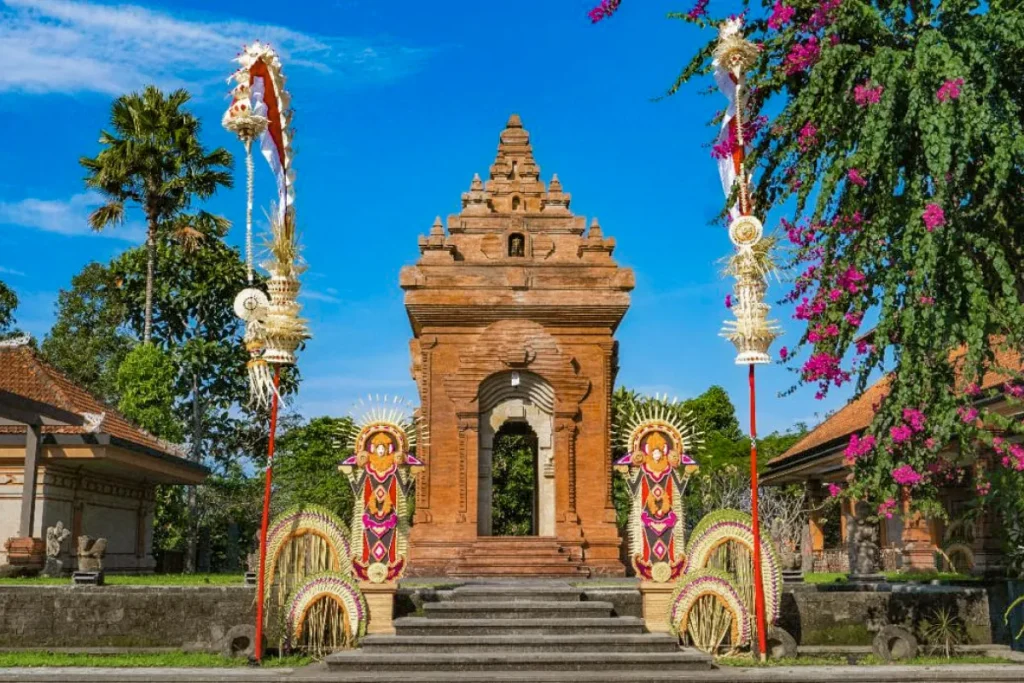
| Google Map Location | Operational hours: Everyday 09.00 – 17.00 WITA (Bali time) | Entrance fee: IDR 75,000 (Children) IDR 75,000 (Students with ID) IDR 150,000 (Adults) |
The Neka Art Museum (NAM), located in Ubud, Bali, offers a comprehensive collection of traditional and modern Balinese art, as well as works by foreign artists inspired by the island’s beauty and culture.
Established in 1982 by Pande Wayan Suteja Neka, a prominent Balinese art dealer, the museum reflects the traditional architecture of a Balinese family compound, and visitors can walk through galleries showcasing classical paintings, contemporary Indonesian art, and pieces influenced by Bali’s culture.
Renovations and updates made by PM Kardi Suteja and PA Laksmi Kardi from 2020 to 2021 enhanced the museum’s buildings and improved the arrangement of its art collection.
23. Pura Gunung Lebah
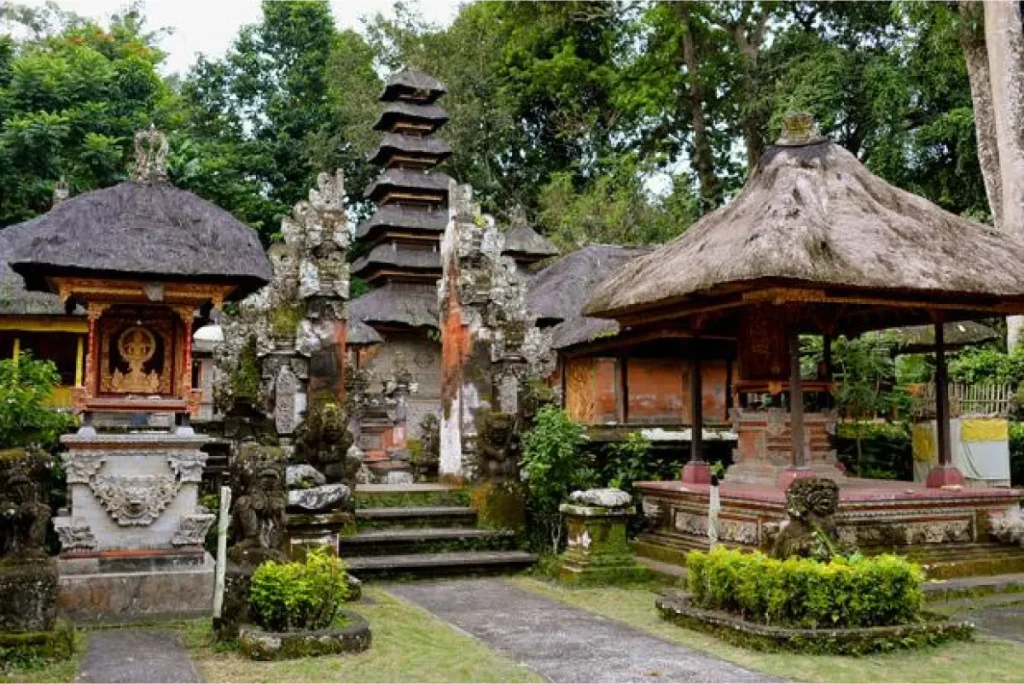
| Google Map Location | Operational hours: Everyday 09.00 – 17.00 WITA (Bali time) | Entrance fee:N/A |
Pura Gunung Lebah, a Balinese Hindu temple, was built in the 8th century by Rsi Markandeya, a priest from India. Rsi Markandeya is credited with founding many temples in Bali, including the famous Pura Besakih at the foot of Mount Agung.
The temple was established after Rsi Markandeya sensed a magical power in the Campuhan Ubud river valley and chose it as a place for meditation after his journey.
The history of Pura Gunung Lebah is intricately linked with the formation of Ubud village. The name “Ubud” derives from Ubad, meaning medicine, due to the abundance of medicinal plants found near the Campuhan river.
The Bottom Line
Bali’s 23 classic landmarks present a blend of culture, nature, and spirituality that’s unlike anywhere else.
Whether you’re drawn to the majestic temples, the lush landscapes, or the rich artistic heritage, these sites offer an unforgettable glimpse into Bali’s soul.
Make these stops a priority on your journey to discover the island’s true magic.
